Japan Radio Co NKE2632 Solid State S-Band Marine Radar User Manual Instruction Manual Funtion Part 5
Japan Radio Co Ltd. Solid State S-Band Marine Radar Instruction Manual Funtion Part 5
Contents
- 1. Installation Manual Part 1
- 2. Installation Manual Part 2
- 3. Installation Manual Part 3
- 4. Installation Manual Part 4
- 5. Installation Manual Part 5
- 6. Installation Manual Part 6
- 7. Installation Manual Part 7
- 8. Installation Manual Part 8
- 9. Installation Manual Part 9
- 10. Installation Manual Part 10
- 11. Installation Manual Part 11
- 12. Instruction Manual Operation Part 1
- 13. Instruction Manual Operation Part 2
- 14. Instruction Manual Operation Part 3
- 15. Instruction Manual Operation Part 4
- 16. Instruction Manual Funtion Part 1
- 17. Instruction Manual Funtion Part 2
- 18. Instruction Manual Funtion Part 3
- 19. Instruction Manual Funtion Part 4
- 20. Instruction Manual Funtion Part 5
- 21. Instruction Manual Funtion Part 6
Instruction Manual Funtion Part 5
![10-17 Section 10 Route Monitoring 1 2 3 4 5 6 7 8 9 10 11 12 13 14 15 16 17 18 19 20 21 22 23 24 25 26 27 10.5 Comparing the Data between the Planned Route and the Actual Route The "Pair of data" dialog box enables comparison of data between the planned route and the actual route. Use the following procedure as below to open the "Pair of data" dialog box. 1 Click on the [Menu] button on the left toolbar. The menu is displayed. 2 Click on the [Route Monitoring] button on the menu. The "Route Monitoring" dialog box appears. 3 Click on the [Pair of data] button. The "Pair of data" dialog box appears. Planned data is displayed in [Plan] (route plan) and the actual route data is displayed in [Actual] (actual route) in the dialog. [1] Planned course Displays a planned course. [2] Planned ship's speed Displays a planned ship’s speed. [3] Planned turn radius Displays a planned turn radius. [4] Planned ETA Displays a planned expected time of arrival. [5] Actual ship’s heading Displays an actual ship’s heading. [5] [6] [7] [8] [1] [2] [3] [4]](https://usermanual.wiki/Japan-Radio-Co/NKE2632.Instruction-Manual-Funtion-Part-5/User-Guide-2791066-Page-1.png)
![Section 10 Route Monitoring 10-18 [6] Actual speed Displays an actual ship’s speed. [7] Actual turn radius Displays an actual turn radius. [8] Actual ETA Displays an expected time of arrival (ETA) that is calculated from the actual ship’s speed.](https://usermanual.wiki/Japan-Radio-Co/NKE2632.Instruction-Manual-Funtion-Part-5/User-Guide-2791066-Page-2.png)
![10-19 Section 10 Route Monitoring 1 2 3 4 5 6 7 8 9 10 11 12 13 14 15 16 17 18 19 20 21 22 23 24 25 26 27 10.6 Verifying Detail Information of WPT Detail information of each WPT on the route can be verified. Use the following procedure to display the detail information of WPT. 1 Right-click on [WPT]. The context menu is displayed. 2 Click on the WPT to be verified from the context menu. The context menu is displayed. 3 Click on [Readout WPT information...]. The detail information dialog of the WPT is displayed. [1] WPT number Displays a WPT number. [2] [Position] (WPT position) Displays the latitude/longitude of WPT. [3] [Name] (WPT name) Displays a WPT name. [2] [1] [3] [4] [5] [6] [7] [8] [9]](https://usermanual.wiki/Japan-Radio-Co/NKE2632.Instruction-Manual-Funtion-Part-5/User-Guide-2791066-Page-3.png)
![Section 10 Route Monitoring 10-20 [4] [DIST] (Distance between own ship and WPT) Displays a distance from the own ship’s position to WPT. [5] [BRG] (Bearing between own ship and WPT) Displays a bearing from the own ship to WPT. [6] [TTG] (Expected time required to reach WTP) Displays a time required to reach WPT based on the own ship’s speed (SOG) and the distance. [7] [ETA] (Expected time of arrival at WPT) Displays an expected time of arrival at WPT based on the own ship’s speed (SOG) and the distance. [8] [Plan ETA] (Expected time of arrival at WPT) Displays an expected time of arrival based on route planning. [9] [Turn Radius] (Turn radius) Displays a WPT turn radius.](https://usermanual.wiki/Japan-Radio-Co/NKE2632.Instruction-Manual-Funtion-Part-5/User-Guide-2791066-Page-4.png)
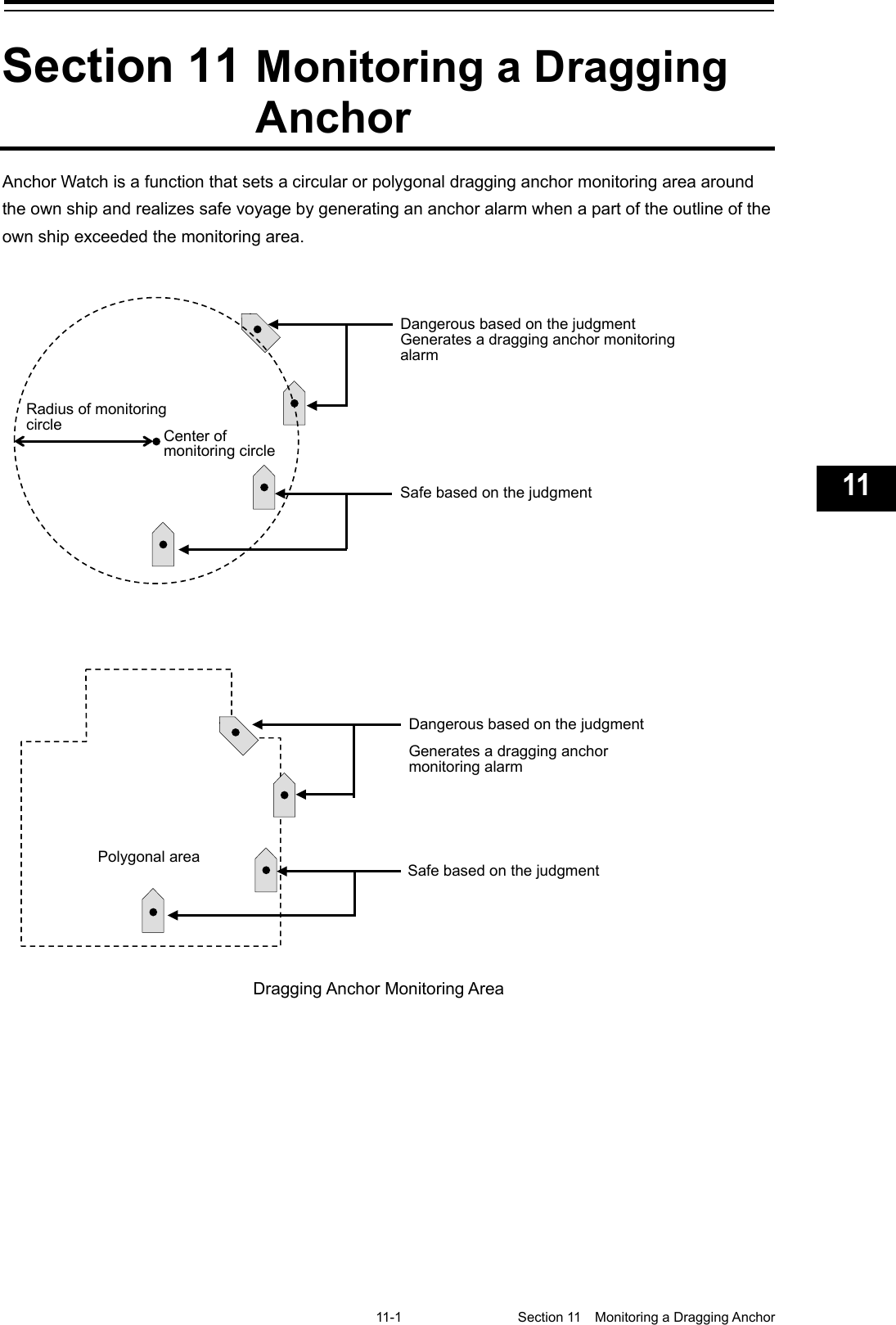
![Section 11 Monitoring a Dragging Anchor 11-2 11.1 Setting a Dragging Anchor Monitoring Area This section describes the setting of a dragging anchor monitoring area. The setting varies depending on whether the shape of the dragging anchor area is a circle or a polygon. 11.1.1 Setting a dragging anchor monitoring circle 1 Click on the [Menu] button on the left toolbar. The menu is displayed. 2 Click on the [Anchor Watch] button on the menu. The "Anchor Watch" dialog box appears. 3 Select [Circle] from the [Mode] (dragging anchor monitoring mode selection) combo box. 4 Enter the center position and size of the dragging anchor monitoring area. [Position] (Input of the center position of the dragging anchor monitoring circle) [Radius] (Radius of the dragging anchor monitoring circle) Input range 10 to 1500 m](https://usermanual.wiki/Japan-Radio-Co/NKE2632.Instruction-Manual-Funtion-Part-5/User-Guide-2791066-Page-6.png)
![11-3 Section 11 Monitoring a Dragging Anchor 1 2 3 4 5 6 7 8 9 10 11 12 13 14 15 16 17 18 19 20 21 22 23 24 25 26 27 付録 11.1.2 Setting a dragging anchor monitoring polygon 1 Click on the [Menu] button on the left toolbar. The menu is displayed. 2 Click on the [Anchor Watch] button on the menu. The "Anchor Watch" dialog box appears. 3 Select [Polygon] from the [Mode] (dragging anchor monitoring mode selection) combo box. 4 Click on the [New] button. The data of the [Point] (vertex) list is cleared. 5 Place the cursor on the chart. 6 Create a polygon by dragging the cursor on the chart. By inputting position coordinates (longitude and latitude) of the vertex position of the polygon in the [Point] list, the vertex position can be changed. When a polygon is created, the number of vertices is displayed in [(Total:)]. Up to 360 vertices can be set.](https://usermanual.wiki/Japan-Radio-Co/NKE2632.Instruction-Manual-Funtion-Part-5/User-Guide-2791066-Page-7.png)
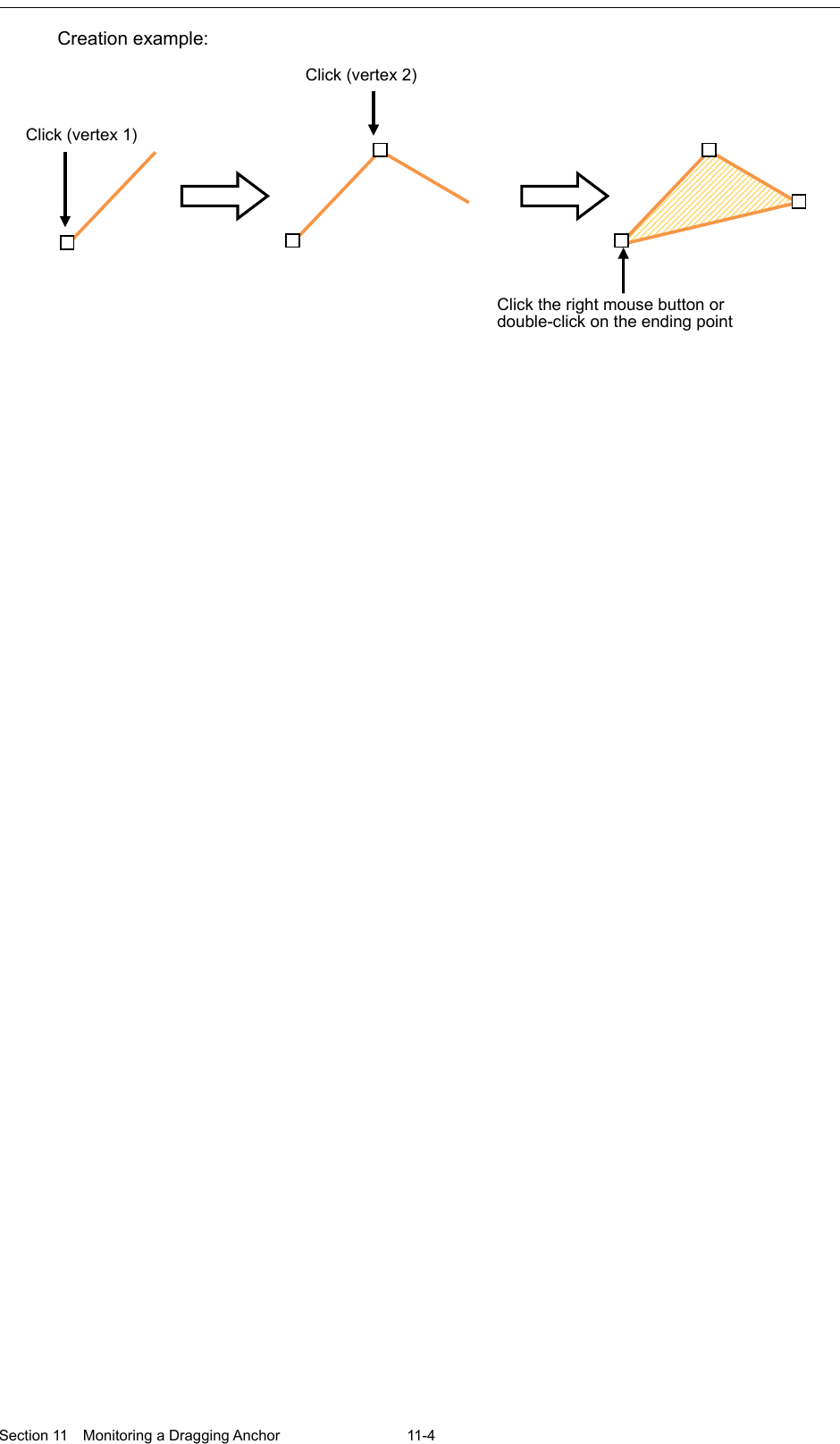
![11-5 Section 11 Monitoring a Dragging Anchor 1 2 3 4 5 6 7 8 9 10 11 12 13 14 15 16 17 18 19 20 21 22 23 24 25 26 27 付録 11.2 Starting and Ending Dragging Anchor Monitoring 11.2.1 Starting dragging anchor monitoring 1 Click on the [Menu] button on the left toolbar. The menu is displayed. 2 Click on the [Anchor Watch] button on the menu. The "Anchor Watch" dialog box appears. The preview of dragging anchor monitoring area that was set is displayed (broken line). When the dialog is displayed, the own ship’s position is placed at the center of the circle.](https://usermanual.wiki/Japan-Radio-Co/NKE2632.Instruction-Manual-Funtion-Part-5/User-Guide-2791066-Page-9.png)
![Section 11 Monitoring a Dragging Anchor 11-6 3 Set dragging anchor monitoring to ON by clicking on the [Monitoring Anchor] button. Dragging anchor monitoring starts based on the setting. The dragging anchor monitoring area on the chart is changed to a solid line. When own ship exits from the dragging anchor monitoring area, the "Dragging anchor" alarm is displayed. 11.2.2 Ending dragging anchor monitoring Set the button display to [OFF] by clicking on the [Monitoring Anchor] button. Alternatively, use the following procedure. 1 Click the dragging anchor monitoring circle. A context menu is displayed. 2 Click [Finish Monitoring Anchor] on the context menu. The [Monitoring Anchor] button display is changed to [OFF] and the display of the dragging anchor monitoring area on the chart is changed to the broken line display.](https://usermanual.wiki/Japan-Radio-Co/NKE2632.Instruction-Manual-Funtion-Part-5/User-Guide-2791066-Page-10.png)
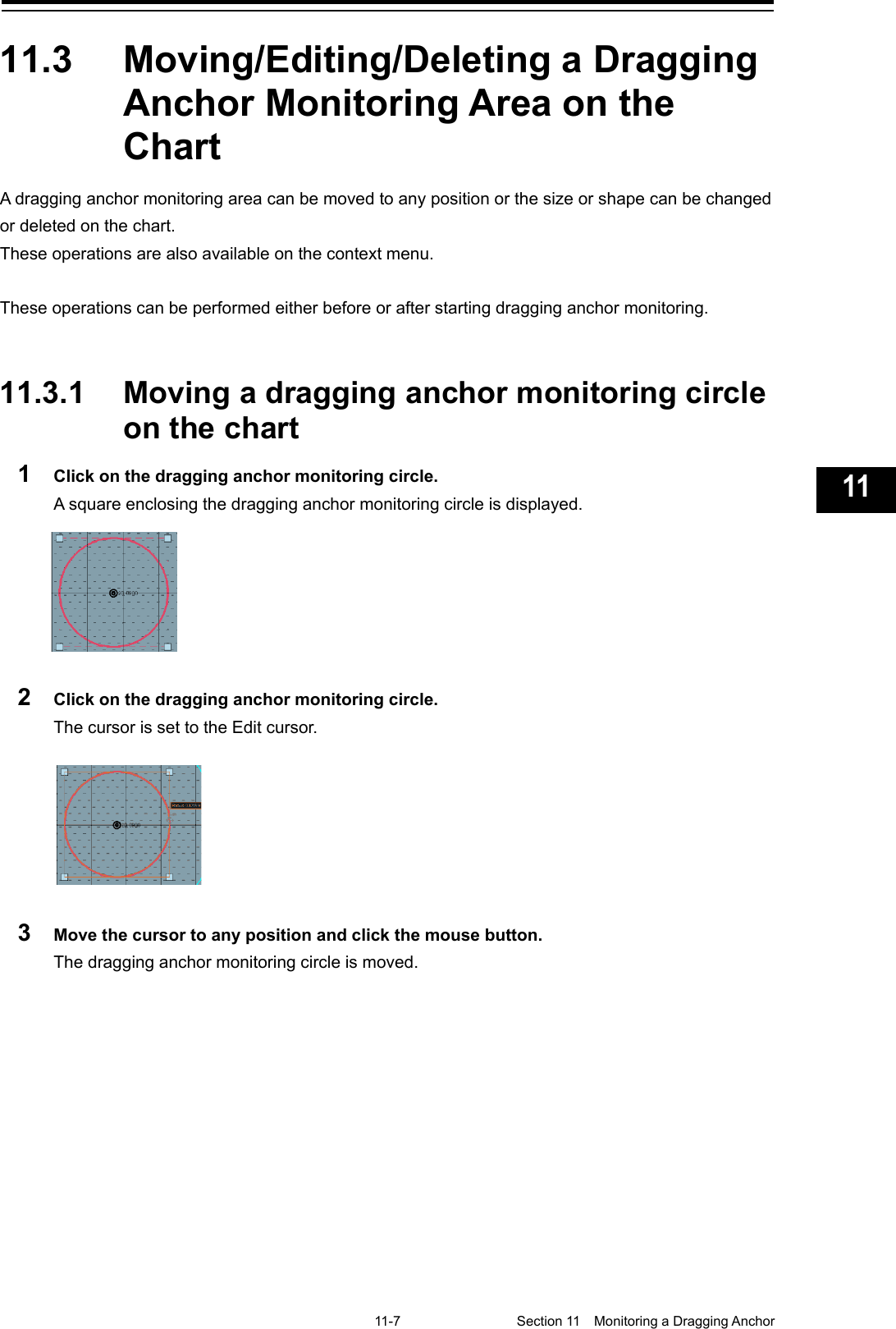
![Section 11 Monitoring a Dragging Anchor 11-8 11.3.2 Moving a dragging anchor monitoring circle on the context menu The moving of a dragging anchor monitoring circle can also be executed from the context menu. 1 Click on the dragging anchor monitoring cirlce. A square enclosing the dragging anchor monitoring circle is displayed. 2 Click the right mouse button on the dragging anchor monitoring circle. The context menu is displayed. 3 Click on [Move this object] on the context menu. The cursor is set to the Edit cursor. 4 Move the cursor to any position and click the mouse button. The dragging anchor monitoring circle is moved. 11.3.3 Moving a dragging anchor monitoring polygon on the chart 1 Click the mouse button inside of the dragging anchor monitoring polygon. The "Anchor Watch" (dragging anchor monitoring) dialog box appears. 2 Click the mouse button inside of the dragging anchor monitoring polygon. The cursor is set to the Edit cursor. 3 Move the cursor to any position and click the mouse button. The dragging anchor monitoring polygon is moved. 11.3.4 Moving a dragging anchor monitoring ploygon on the context menu The moving of a dragging anchor monitoring polygon can also be executed from the context menu. 1 Click the right mouse button on a line of the dragging anchor monitoring polygon. A context menu is displayed. 2 Click on [Move this object] on the context menu. The cursor is set to the Edit cursor. 3 Move the cursor to any position and click the mouse button. The dragging anchor monitoring polygon is moved. Edit](https://usermanual.wiki/Japan-Radio-Co/NKE2632.Instruction-Manual-Funtion-Part-5/User-Guide-2791066-Page-12.png)
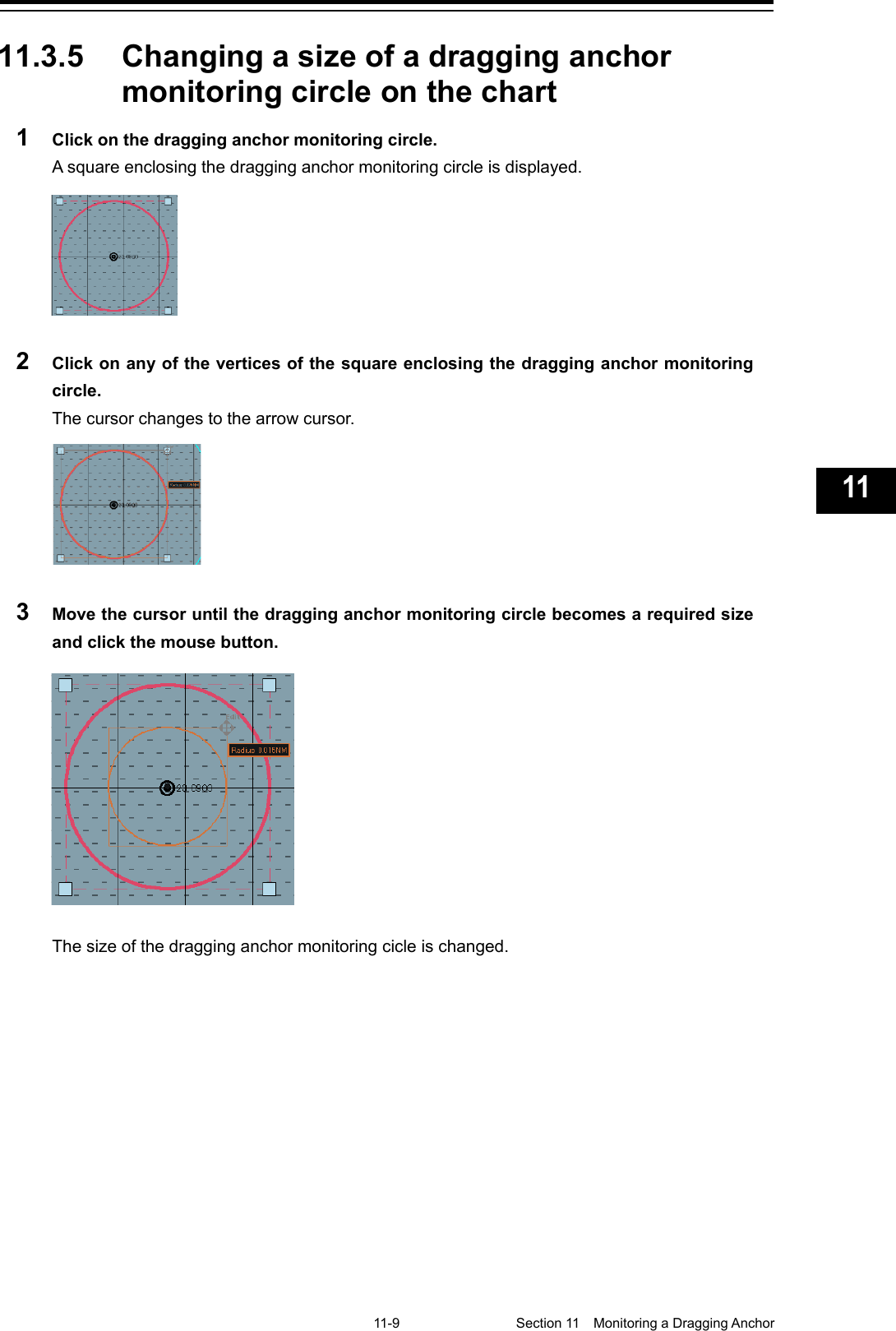
![Section 11 Monitoring a Dragging Anchor 11-10 11.3.6 Changing a size of a dragging anchor monitoring circle on the context menu Change of a dragging anchor monitoring circle can also be executed from the context menu. 1 Click on the dragging anchor monitoring circle. A square enclosing the dragging anchor monitoring circle is displayed. 2 Click on any of the vertexes of the square enclosing the dragging anchor monitoring circle. A context menu is displayed. 3 Click on [Change radius] on the context menu. The cursor is set to the Arrow cursor. 4 Move the cursor until the dragging anchor monitoring circle becomes a required size and click the mouse button. The size of the dragging anchor monitoring circle is changed. 11.3.7 Changing a shape of a dragging anchor monitoring polygon on the chart Changing a vertex 1 Click on the vertex of the dragging anchor monitoring polygon to be changed. The cursor is set to the Edit cursor. 2 Move the cursor to the required vertex position of the dragging anchor monitoring polygon and click the mouse button. The position of the vertex is changed. Edit Edit](https://usermanual.wiki/Japan-Radio-Co/NKE2632.Instruction-Manual-Funtion-Part-5/User-Guide-2791066-Page-14.png)
![11-11 Section 11 Monitoring a Dragging Anchor 1 2 3 4 5 6 7 8 9 10 11 12 13 14 15 16 17 18 19 20 21 22 23 24 25 26 27 付録 Adding a vertex 1 Click the mouse button on the position where a vertex to be added. The cursor is set to the Edit cursor. 2 Move the cursor to the position where a vertex is to be set and click the mouse button. A new vertex is added. 11.3.8 Changing a shape of a dragging anchor monitoring polygon on the context menu The following operation can be performed on the context menu that is displayed by clicking the right mouse button on the dragging anchor monitoring polygon. Each function is as follows. [Insert vertex] (Addition of a vertex) Adds a vertex at the position where the mouse button is clicked on. [Delete vetex] (Deletion of a vertex) Deletes the selected vertex. [Move this object] (Moving an object) Moves the selected dragging anchor monitoring polygon to any position. [Delete this object] (Deletion of an object) Deletes a selected dragging anchor monitoring polygon. Edit Edit [Clicking the right mouse button on the line other than vertices of the dragging anchor monitoring polygon] [Clicking the right mouse button on a vertex of a dragging anchor monitoring polygon]](https://usermanual.wiki/Japan-Radio-Co/NKE2632.Instruction-Manual-Funtion-Part-5/User-Guide-2791066-Page-15.png)
![Section 11 Monitoring a Dragging Anchor 11-12 Note When deletion of a dragging anchor monitoring polygon is attempted during execution of dragging anchor monitoring, the following message dialog box is displayed. To execute deletion, click on the [Yes] button. The monitoring area is deleted and dragging anchor monitoring is terminated.](https://usermanual.wiki/Japan-Radio-Co/NKE2632.Instruction-Manual-Funtion-Part-5/User-Guide-2791066-Page-16.png)
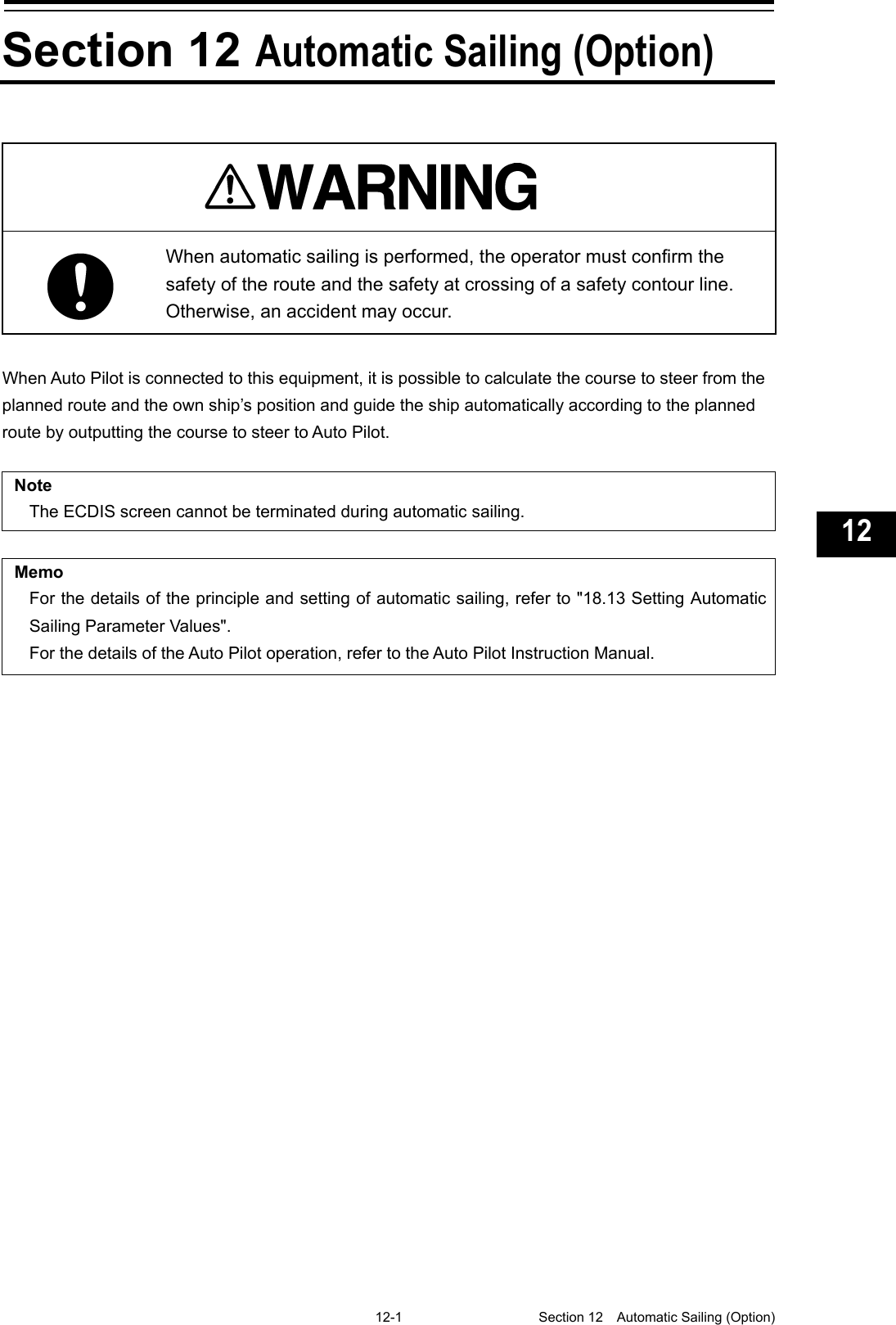
![Section 12 Automatic Sailing (Option) 12-2 12.1 Flow of Starting Automatic Sailing 1 Click on the [Menu] button on the left toolbar. The menu is displayed. 2 Click on the [Auto Sail] - [Start] on the menu. The automatic sailing starting wizard ("Auto Sail" dialog box) appears. 3 Click a planned route file to be used from the [Route] combo box of Procedure tab 1. 4 After checking a route, click on the [Next] button. Procedure tabs [Route] combo box New route planning link](https://usermanual.wiki/Japan-Radio-Co/NKE2632.Instruction-Manual-Funtion-Part-5/User-Guide-2791066-Page-18.png)
![12-3 Section 12 Automatic Sailing (Option) 1 2 3 4 5 6 7 8 9 10 11 12 13 14 15 16 17 18 19 20 21 22 23 24 25 26 27 付録 The dialog of Procedure tab 2 is displayed. 5 Click on the waypoint from which Auto Sail is to start from the [TO-WPT] (waypoint) combo box. [TO-WPT] combo box](https://usermanual.wiki/Japan-Radio-Co/NKE2632.Instruction-Manual-Funtion-Part-5/User-Guide-2791066-Page-19.png)
![Section 12 Automatic Sailing (Option) 12-4 6 Start automatic sailing by clicking on the [Start] button. During route monitoring During route monitoring, the name of the planned route that is currently used is displayed in the [Route] combo box. To use another planned route for automatic sailing, re-select a planned route.](https://usermanual.wiki/Japan-Radio-Co/NKE2632.Instruction-Manual-Funtion-Part-5/User-Guide-2791066-Page-20.png)
![12-5 Section 12 Automatic Sailing (Option) 1 2 3 4 5 6 7 8 9 10 11 12 13 14 15 16 17 18 19 20 21 22 23 24 25 26 27 付録 Occurrence of an error The following message dialog box appears. When the above error occurs, automatic sailing cannot be started. Cancel the alert by closing the dialog box by clicking on the [X] (Close) button. For the details of the alerts that are displayed during automatic sailing, refer to "12.6 Alerts at Automatic Sailing". Creating a new route 1 Click on the [Click here to plan a new route] link. The "Route Planning" dialog box appears. For the details, refer to "12.2.2 Creating a new route".](https://usermanual.wiki/Japan-Radio-Co/NKE2632.Instruction-Manual-Funtion-Part-5/User-Guide-2791066-Page-21.png)
![Section 12 Automatic Sailing (Option) 12-6 12.2 Selecting a Route 12.2.1 Using the existing planned route 1 To use the existing planned track for automatic sailing, select the planned route file to be used from the [Route] combo box. Checking of the selected route starts. If there is no problem in the route, a route safety confirmation message is displayed and the [Next] button is enabled. [Next] button](https://usermanual.wiki/Japan-Radio-Co/NKE2632.Instruction-Manual-Funtion-Part-5/User-Guide-2791066-Page-22.png)
![12-7 Section 12 Automatic Sailing (Option) 1 2 3 4 5 6 7 8 9 10 11 12 13 14 15 16 17 18 19 20 21 22 23 24 25 26 27 付録 Detecting an error When an error is detected as a result of checking the route, an error message is displayed. Change the route file or modify the selected route. Use the following procedure for modifying a route. 1 Click on the [Click here to confirm and modify the route] (confirmation and modification of route) link. The "Route Planning" dialog box is opened. When an error occurred in the planned route, a badge indicating the number of errors is displayed on the [Show Route Check…] (route checking screen display) button.](https://usermanual.wiki/Japan-Radio-Co/NKE2632.Instruction-Manual-Funtion-Part-5/User-Guide-2791066-Page-23.png)
![Section 12 Automatic Sailing (Option) 12-8 2 Click on the [Show Route Check…] button. The "Check Route" dialog box that displays the result of the route checking appears. 3 Modify the route, save the file by overwriting, and close the "Route Planning" dialog box. The route safety confirmation message is displayed. For the details of the route planning operation, refer to "Section 9 Route Planning" 12.2.2 Creating a new route A new planned route to be used for automatic sailing can be created. 1 Click on the [Click here to plan a new route] link. The "Route Planning" dialog box is opened. Re-check button Limit check tab Safety check tab Error count badge [Disregard] button](https://usermanual.wiki/Japan-Radio-Co/NKE2632.Instruction-Manual-Funtion-Part-5/User-Guide-2791066-Page-24.png)
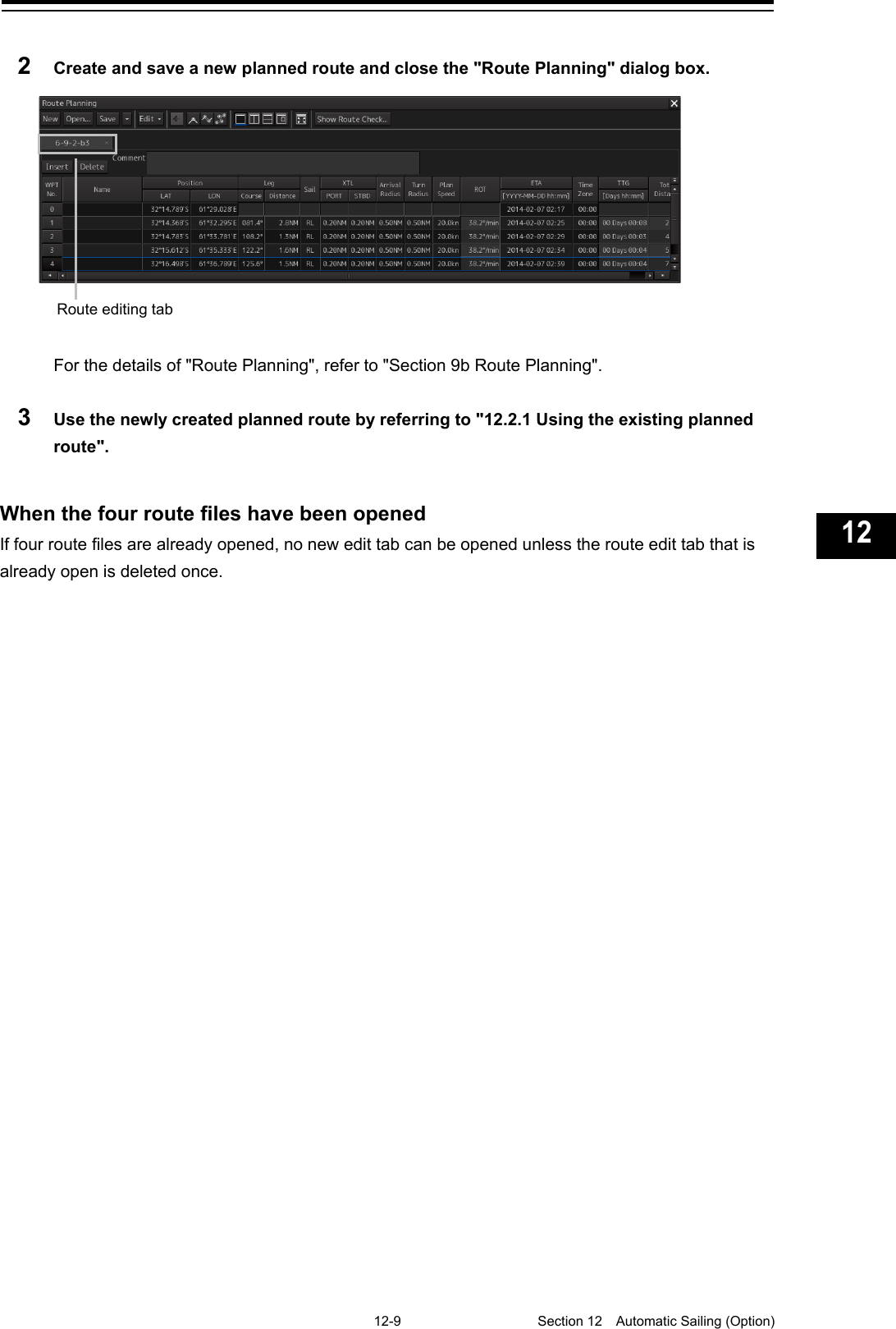
![Section 12 Automatic Sailing (Option) 12-10 12.3 Selecting a Waypoint at which Automatic Sailing Starts Select a WPT (waypoint) at which automatic sailing starts. 1 Click on Procedure tab 2. When selecting Procedure tab 1, click on the [Next] button. When the [Back] button is clicked on, control returns to the route selection screen, enabling re-selection of a route. 2 Click on the waypoint at which automatic sailing starts from the [TO-WPT] combo box. Note When the "Auto Sail" dialog box is activated during route monitoring, WPT that has been passed through cannot be selected.](https://usermanual.wiki/Japan-Radio-Co/NKE2632.Instruction-Manual-Funtion-Part-5/User-Guide-2791066-Page-26.png)
![12-11 Section 12 Automatic Sailing (Option) 1 2 3 4 5 6 7 8 9 10 11 12 13 14 15 16 17 18 19 20 21 22 23 24 25 26 27 付録 Creation of the temporary route to the selected WPT starts. When the temporary route is created, a completion message and the [Start] button are displayed. When a temporary route cannot be created, the following error message is displayed. Error message Cause Measures Cannot create the temporary route because the course is inappropriate. Turn the course toward the planned course. The temporary route could not be created due to the inappropriate course. Approximate the ship’s heading to the planned route. Cannot create the temporary route because the XTD exceed XTD MAX. Move own ship toward the planned route. Since XTD is too large, the temporary route could not be created. Approximate own ship to the planned route. Cannot create the temporary route because own ship may pass through the WOL. Select the TO-Waypoint again. Since own ship may pass through the WOL, the temporary route could not be created. Re-select TO-WPT. Cannot create the temporary route because own ship may pass through the planned route leg. Select the TO-Waypoint again. Since own ship may pass through the planned route leg, the temporary route could not be created. Re-select TO-WPT. [Start] button](https://usermanual.wiki/Japan-Radio-Co/NKE2632.Instruction-Manual-Funtion-Part-5/User-Guide-2791066-Page-27.png)
![Section 12 Automatic Sailing (Option) 12-12 12.4 Starting Automatic Sailing If your ship has reached a veering circle during the automatic navigation, make sure that the safety check and veering operation are made by the ship operator himself. If veering operation is not made, regression bearing will be maintained without veering. This may cause an accident. Input the ship’s parameter accurately according to the specification of the ship. Otherwise, accidents may result. Do not neglect confirmation of the position and the bearing of own ship during sailing regardless of whether automatic sailing is set to ON or OF F. Otherwise, an accident may occur. 1 Click on the [Start] button of Procedure tab 2. [Start] button](https://usermanual.wiki/Japan-Radio-Co/NKE2632.Instruction-Manual-Funtion-Part-5/User-Guide-2791066-Page-28.png)
![12-13 Section 12 Automatic Sailing (Option) 1 2 3 4 5 6 7 8 9 10 11 12 13 14 15 16 17 18 19 20 21 22 23 24 25 26 27 付録 The "Auto sail" dialog box is closed and the Autopilot steering mode switching message is displayed. Switch the Autopilot steering mode to the NAVI mode. The selected planned route is displayed on the chart and the “Voyage Information” dialog is displayed. When the "Route Planning" dialog box is opened during automatic sailing, the [Autosailing] (during automatic sailing) indicator is displayed on the tab of the planned route that is currently used. [Auto Sailing] indicator](https://usermanual.wiki/Japan-Radio-Co/NKE2632.Instruction-Manual-Funtion-Part-5/User-Guide-2791066-Page-29.png)
![Section 12 Automatic Sailing (Option) 12-14 12.5 Stopping Automatic Sailing 1 Click on the [Auto Sail Stop] button of the auto pilot information. The automatic sailing stopping confirmation dialog box appears. 2 Click on the [OK] button. Auto Sail stops and an auto pilot steering mode switching confirmation dialog box appears. Change the Autopilot steering mode to the Manual mode. 3 Click on [×] (Close). The auto pilot steering mode switching confirmation dialog box is closed. [Auto Sail Stop] button](https://usermanual.wiki/Japan-Radio-Co/NKE2632.Instruction-Manual-Funtion-Part-5/User-Guide-2791066-Page-30.png)
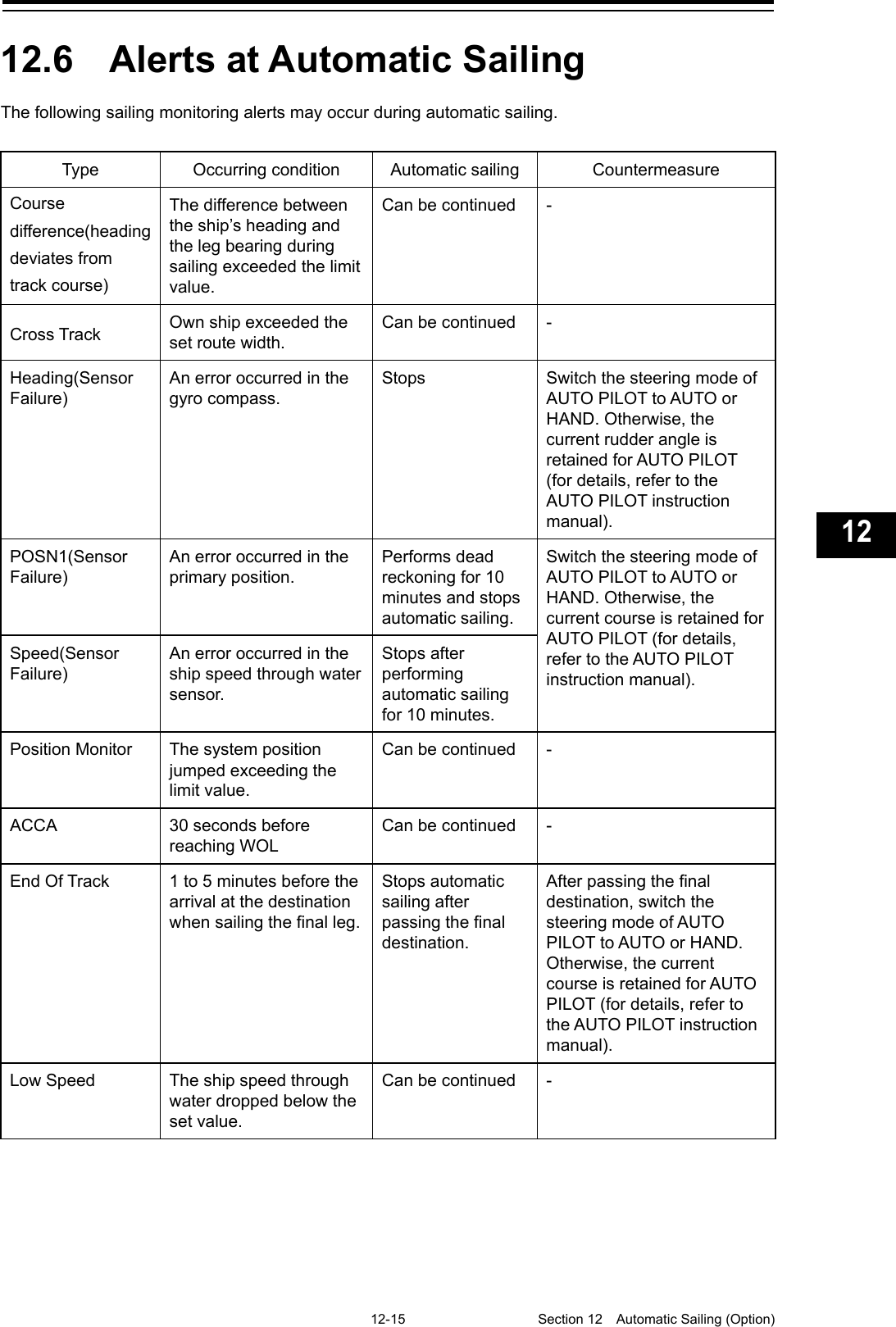
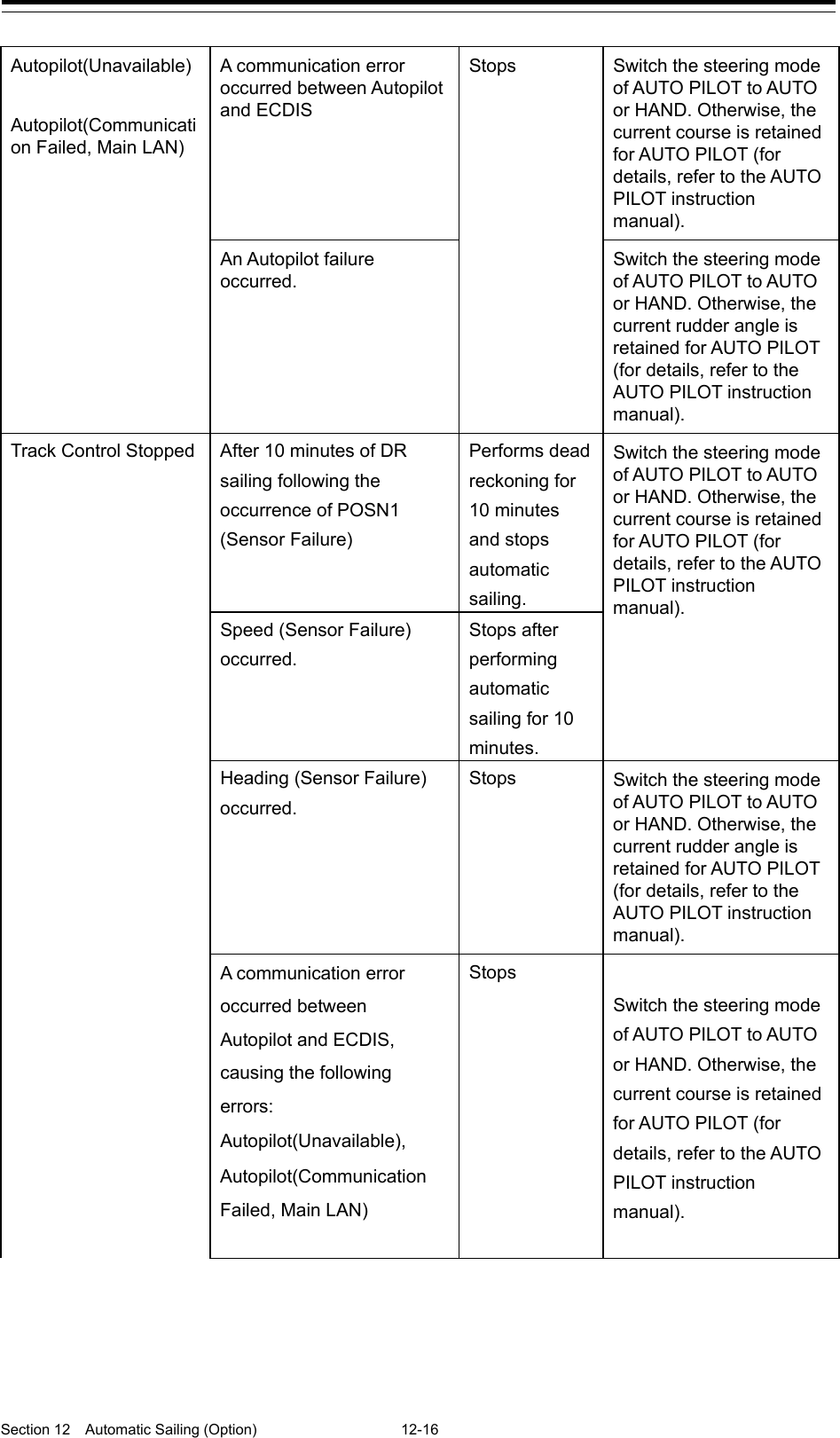
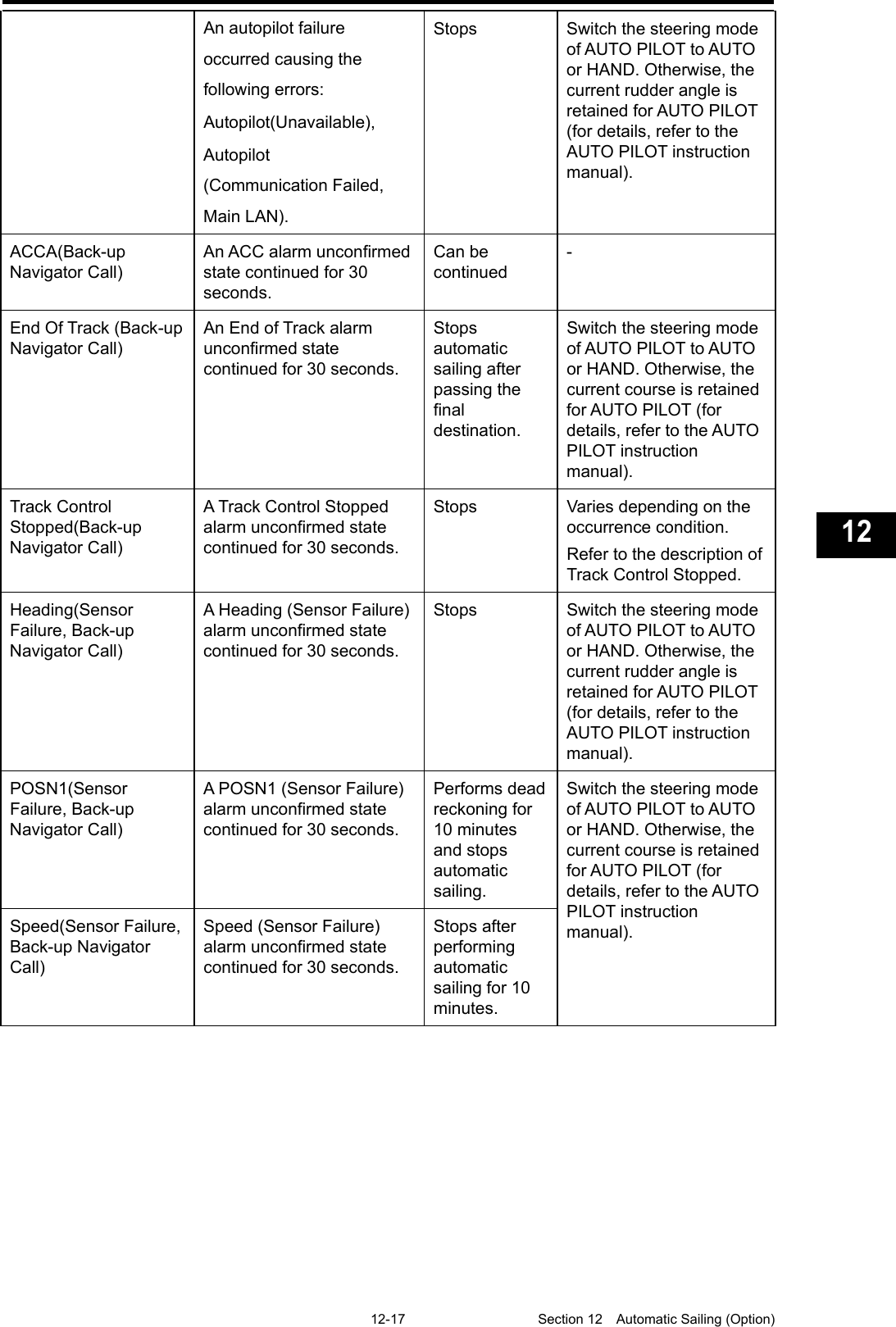
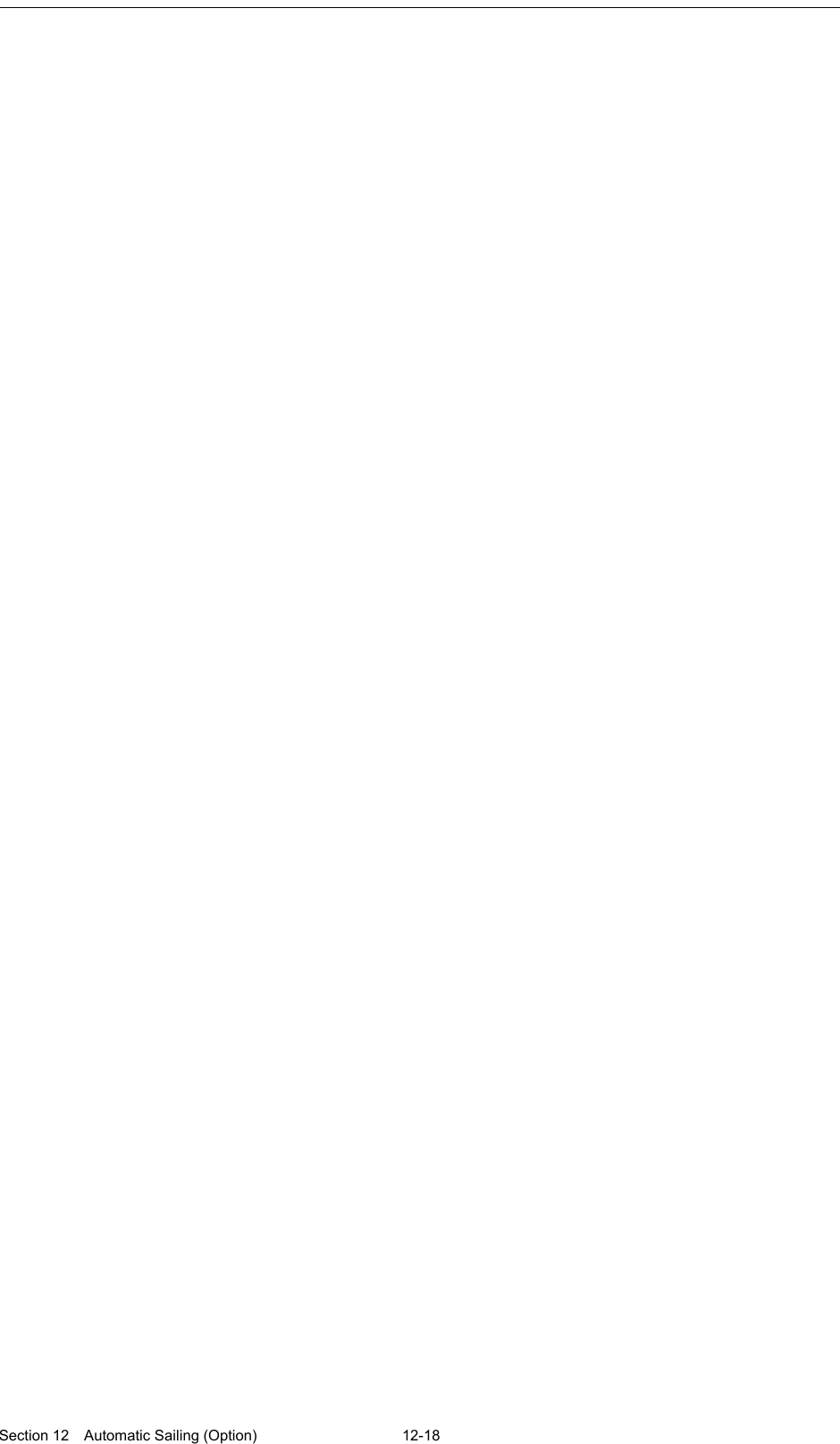
![13-1 Section 13 Operating a Chart (option) 1 2 3 4 5 6 7 8 9 10 11 12 13 14 15 16 17 18 19 20 21 22 23 24 25 26 27 付録 Section 13 Operating a Chart (option) Use the [Chart] menu for chart operations. 1 Click on the [Menu] button on the left toolbar. The menu is displayed 2 Click on the [Chart] button on the menu. The submenu is displayed. It is possible using the page switching buttons to switch to the first page and the second page of the submenu screen. Click each button of the submenu screen to display the relevant function dialog. Button name Function Related section Target First page Manual Update Updates a chart manually 13.1 Updating a Chart Manually ECDIS, CHART RADAR My Port List Operates a port name list 8.7 My Port List ECDIS Select S-57 Chart Selects an S-57 chart 13.2 Displaying/Searching an S-57 Chart [Select S-57 Chart] Off Center by Entering Position Moves the display center 13.3 Displaying a Chart by Inputting a Position Accept S-57 Updates Accepts the updated S-57 chart 13.4 Confirming/Accepting an S-57 Updated Chart Date-dependent View Displays a date-dependent object 13.5 Displaying a Date-dependent Object Chart Boundary Displays a chart boundary 13.6 Displaying a Chart Boundary Chart Abbreviation Chart abbreviation 13.9 Displaying a Chart Abbreviation List ECDIS, CHART RADAR](https://usermanual.wiki/Japan-Radio-Co/NKE2632.Instruction-Manual-Funtion-Part-5/User-Guide-2791066-Page-35.png)
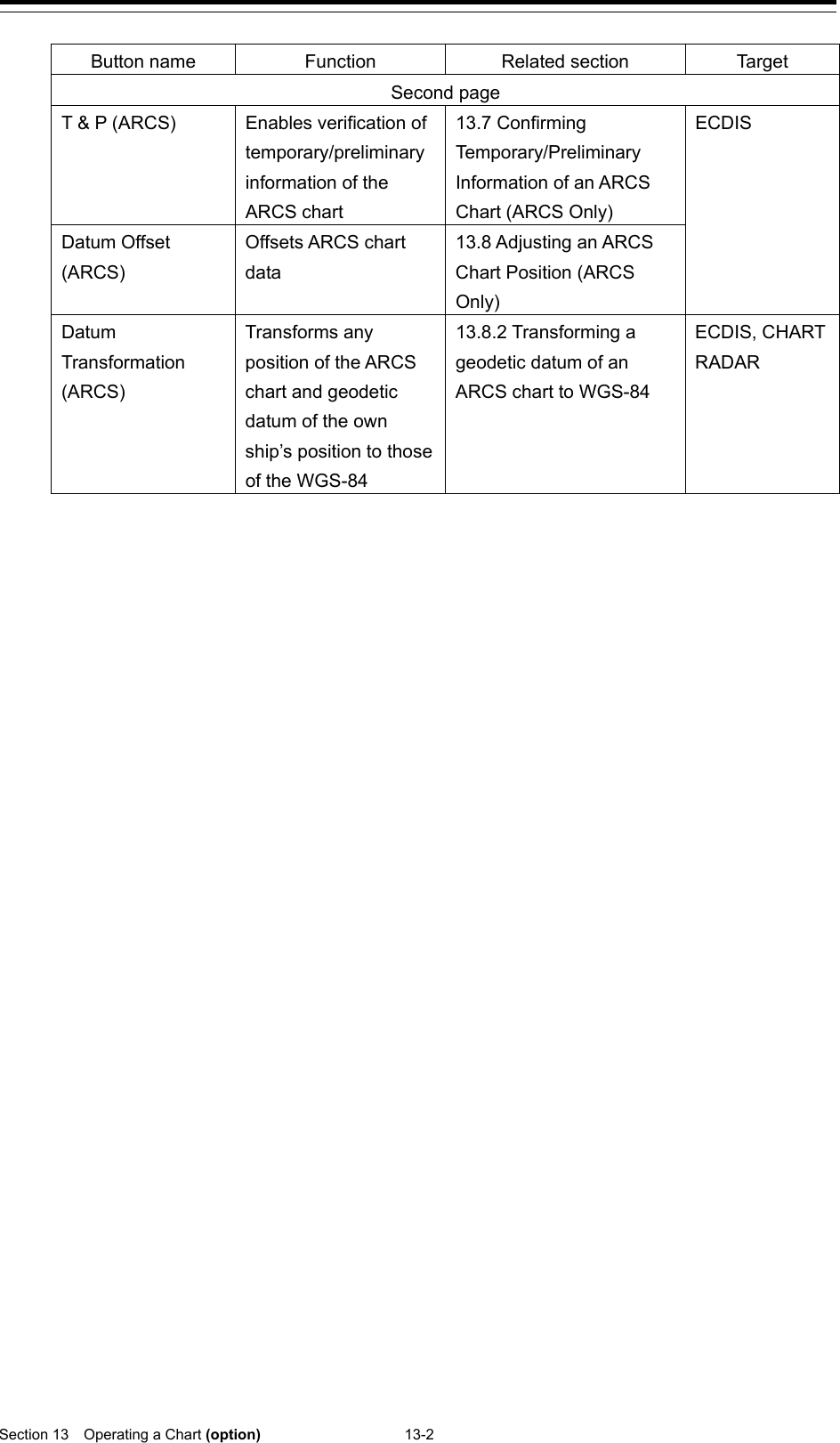
![13-3 Section 13 Operating a Chart (option) 1 2 3 4 5 6 7 8 9 10 11 12 13 14 15 16 17 18 19 20 21 22 23 24 25 26 27 付録 13.1 Updating a Chart Manually The chart can be updated manually by selecting [Chart] - [Manual Update] (chart manual update) on the menu. For the details of manual update of a chart, refer to "14.3 Updating a Chart Manually (ECDIS Screen Only)".](https://usermanual.wiki/Japan-Radio-Co/NKE2632.Instruction-Manual-Funtion-Part-5/User-Guide-2791066-Page-37.png)
![Section 13 Operating a Chart (option) 13-4 13.2 Displaying/Searching an S-57 Chart [Select S-57 Chart] 13.2.1 Displaying a chart Select S-57 Chart enables selection and display of any chart. 1 Click on the [Menu] button on the left toolbar. The menu is displayed 2 Click on the [Chart] - [Select S-57 Chart] on the menu. The "Select Chart" dialog box appears. An S-57 chart list contains chart names (Name), original scales (Scale), Updating numbers (Up No.), issuing dates (Issue date), last update dates (Last Update), and update acceptance statuses (Accepted, Yes: Accepted/No: Not accepted). 3 Click on the line of the chart to be displayed from the S-57 chart list. The chart is selected. 4 Click on the [OK] button. The selected chart is displayed on the screen. S-57 chart list](https://usermanual.wiki/Japan-Radio-Co/NKE2632.Instruction-Manual-Funtion-Part-5/User-Guide-2791066-Page-38.png)
![13-5 Section 13 Operating a Chart (option) 1 2 3 4 5 6 7 8 9 10 11 12 13 14 15 16 17 18 19 20 21 22 23 24 25 26 27 付録 13.2.2 Search a chart 13.2.2.1 Searching the position that is clicked on by the cursor 1 Click on the [Menu] button on the left toolbar. The menu is displayed 2 Click on the [Chart] - [Select S-57 Chart] on the menu. The "Select Chart" dialog box appears. 3 Move the cursor to the position to be searched and click the mouse button. The chart that is set at the position specified by clicking the mouse button is displayed in the S-57 chart list. Clearing search results Click on the [Reset Picked Chart] (chart selection reset) button. Click.](https://usermanual.wiki/Japan-Radio-Co/NKE2632.Instruction-Manual-Funtion-Part-5/User-Guide-2791066-Page-39.png)
![Section 13 Operating a Chart (option) 13-6 13.2.2.2 Searching by using a chart name 1 Click on the [Menu] button on the left toolbar. The menu is displayed 2 Click on the [Chart] - [Select S-57 Chart] on the menu. The "Select Chart" dialog box appears. 3 Enter a chart name in the search box Clearing search results Clear by using the [DEL] key on the software keyboard. Search box The chart is displayed.](https://usermanual.wiki/Japan-Radio-Co/NKE2632.Instruction-Manual-Funtion-Part-5/User-Guide-2791066-Page-40.png)
![13-7 Section 13 Operating a Chart (option) 1 2 3 4 5 6 7 8 9 10 11 12 13 14 15 16 17 18 19 20 21 22 23 24 25 26 27 付録 13.3 Displaying a Chart by Inputting a Position By inputting a position, the chart of the position that was input can be displayed. 1 Click on the [Menu] button on the left toolbar. The menu is displayed 2 Click on the [Chart] - [Off Center by Entering Position] on the menu. The "Off Center by Entering Position" dialog box appears. 3 Enter a position of the chart to be displayed in the latitude/longitude input box. 4 Click on the [Jump to the Following Position] button. The chart of the specified position is displayed. Latitude/longitude input box](https://usermanual.wiki/Japan-Radio-Co/NKE2632.Instruction-Manual-Funtion-Part-5/User-Guide-2791066-Page-41.png)
![Section 13 Operating a Chart (option) 13-8 13.4 Confirming/Accepting an S-57 Updated Chart The update contents of an S-57 updated chart can be confirmed. By accepting an updated chart, the updated chart can be integrated into the original chart. Note Check that the display category of the chart is [Standard] or [All]. When the display category is set to [Base], the updated chart may not be displayed. 1 Click on the [Menu] button on the left toolbar. The menu is displayed. 2 Click on the [Chart] - [Accept S-57 Updates] on the menu. The "Accept S-57 Updates" dialog box appears. 3 To confirm the update contents of the updated chart, select the check box of the chart and click on the [Show] (display) button. The selected updated chart is displayed. The updated chart is displayed on the original chart in red. 4 Click on the [Accept] button to accept the updated chart. The updated chart is integrated into the original chart. Chart selection check box Updated S-57 chart list Clicking on the [Accept] button: The object is approved and is displayed in the same color as for the original chart. Clicking on the [Show] button: The updated chart that overlaps the original chart is displayed in red.](https://usermanual.wiki/Japan-Radio-Co/NKE2632.Instruction-Manual-Funtion-Part-5/User-Guide-2791066-Page-42.png)
![13-9 Section 13 Operating a Chart (option) 1 2 3 4 5 6 7 8 9 10 11 12 13 14 15 16 17 18 19 20 21 22 23 24 25 26 27 付録 13.5 Displaying a Date-dependent Object A chart object of the specified date and time can be displayed. For instance, it is possible to display a date-dependent chart such as displaying a chart at the arrival time of the arrival schedule at the navigation planning. 1 Click on the [Menu] button on the left toolbar. The menu is displayed 2 Click on the [Chart] - [Date-dependent View] on the menu. The "Date-dependent View" dialog box appears. 3 Set the [UTC] (Universal Time Coordinated) button or [LMT] (Local Mean Time) button to On by clicking on the button. 4 Enter a date in the [Date] input box within the range from 1980-01-01 to 2099-12-31. 5 Enter a time (24-hour system) in the [Time] input box. 6 When [LMT] is set to On in Step 3, enter a time difference in [Time Zone] box within the range from -13:30 to +13:30. The object displayed on the chart is updated when information is input in any of the steps from Step 4 to Step 6. 7 Close the "Date-dependent View" dialog box. The current time is displayed on the chart again.](https://usermanual.wiki/Japan-Radio-Co/NKE2632.Instruction-Manual-Funtion-Part-5/User-Guide-2791066-Page-43.png)
![Section 13 Operating a Chart (option) 13-10 13.6 Displaying a Chart Boundary The boundary of the chart on the position on which the button was clicked is displayed. 13.6.1 Setting a boundary to be displayed on the chart A chart boundary can be displayed. 1 Click on the [Menu] button on the left toolbar. The menu is displayed. 2 Click on the [Chart] - [Chart Boundary] on the menu. The "Chart Boundary" dialog box appears. 3 Select the chart whose boundary is to be displayed among the [Chart Boundary] check boxes. 4 To display the chart name in addition to the boundary, select [Show Chart Name]. 5 To display ordinary chart information in addition to the boundary, select [Show ENC Data] (displaying chart information). When this item is not selected, the background chart is displayed. Overview chart General chart Coastal chart Approach chart Harbour chart Berthing chart](https://usermanual.wiki/Japan-Radio-Co/NKE2632.Instruction-Manual-Funtion-Part-5/User-Guide-2791066-Page-44.png)
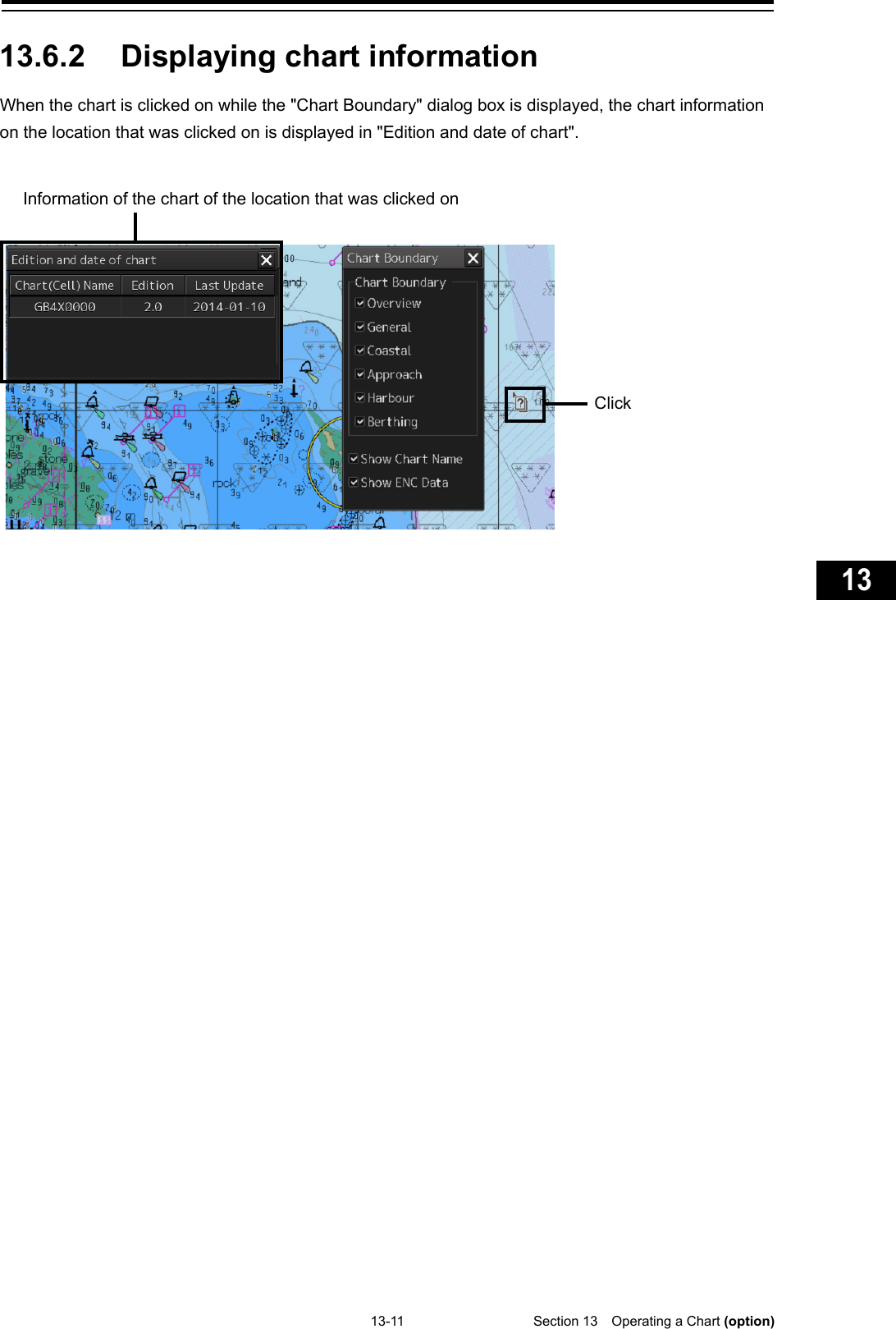
![Section 13 Operating a Chart (option) 13-12 13.7 Confirming Temporary/Preliminary Information of an ARCS Chart (ARCS Only) Temporary/preliminary information (T&P: Temporary and Preliminary Notices) of an ARCS chart can be confirmed. 1 Click on the [Menu] button on the left toolbar. The menu is displayed. 2 Click on the [Chart] - [T & P] on the menu. The "T & P" dialog box appears. 3 Click on the number whose contents are to be confirmed on the [Number] list. The temporary/preliminary information of the chart of the specified number is displayed on the right side. The list can be sorted by clicking on any item of the title column. Note Temporary/preliminary information is included in the ARCS chart itself. Since the information may not be included depending on the chart, the information may not be displayed.](https://usermanual.wiki/Japan-Radio-Co/NKE2632.Instruction-Manual-Funtion-Part-5/User-Guide-2791066-Page-46.png)
![13-13 Section 13 Operating a Chart (option) 1 2 3 4 5 6 7 8 9 10 11 12 13 14 15 16 17 18 19 20 21 22 23 24 25 26 27 付録 13.8 Adjusting an ARCS Chart Position (ARCS Only) Note Adjust the offet only when the geodetic datum of the chart is a local geodetic datum and the display position is not adjusted correctly. 13.8.1 Offsetting an ARCS chart Move the chart by entering offset values (latitude and longitude) or using the cursor. 1 Click on the [Menu] button on the left toolbar. The menu is displayed. 2 Click on the [Chart] - [Datum Offset] (geodetic offset) on the menu. The [Datum Offset] (geodetic offset) dialog box appears. When the previous setting values are displayed in the [Off set] box, the values can be cleared by clicking on the [Clear Offset] button. To set offset of a chart, use the cursor or enter offset values. Offsetting a chart with the cursor 1 Click on the [Offset by Cursor] button. The button display changes to On and the offset function is enabled. 2 Set the cursor to the reference point and click the mouse button. To clear the offset values, set the button to Off by clicking on the [Offset by Cursor] button.](https://usermanual.wiki/Japan-Radio-Co/NKE2632.Instruction-Manual-Funtion-Part-5/User-Guide-2791066-Page-47.png)
![Section 13 Operating a Chart (option) 13-14 3 Place the cursor on the offset position and click the mouse button. The reference point moves to the offset position. A check mark ( ) is displayed on the [Offset] display (start of offset). Offsetting a chart by entering an offset value 1 Enter offset values (latitude/longitude) in the [Offset] box. The chart is offset. Cursor Orange line Offset amount](https://usermanual.wiki/Japan-Radio-Co/NKE2632.Instruction-Manual-Funtion-Part-5/User-Guide-2791066-Page-48.png)
![13-15 Section 13 Operating a Chart (option) 1 2 3 4 5 6 7 8 9 10 11 12 13 14 15 16 17 18 19 20 21 22 23 24 25 26 27 付録 13.8.2 Transforming a geodetic datum of an ARCS chart to WGS-84 A geodetic datum of an ARCS chart can be transformed to WGS-84 based on any position and the own ship’s position. 1 Click on the [Menu] button on the left toolbar. The menu is displayed. 2 Click on the [Chart] - [Datum Transformation] (geodetic datum transformation) on the menu. The [Datum Transformation] (geodetic datum transformation) dialog box appears.](https://usermanual.wiki/Japan-Radio-Co/NKE2632.Instruction-Manual-Funtion-Part-5/User-Guide-2791066-Page-49.png)
![Section 13 Operating a Chart (option) 13-16 3 Select a geodetic system from the [From] combo box of [Geodetic Datum]. Note Chart display position in the WGS84 geodetic datum Chart display position in the local geodetic datum X and Y: Offset amount to WGS84 When X and Y are included in the chart information, the system automatically offsets the amount to WGS84 and displays the result. In this case, a check mark is attached to RNC Offset of "Chart Information Area (RNC)" and "Chart Shift to WGS84" is displayed in the alert notification area. As shown above, even if the offset amount is determined in the "Datum Transformation" dialog box for the chart that is displayed under WGS-84 and the [OK] button is clicked on, this function is disabled and the message, "The Datum is already WGS-84", is displayed.](https://usermanual.wiki/Japan-Radio-Co/NKE2632.Instruction-Manual-Funtion-Part-5/User-Guide-2791066-Page-50.png)
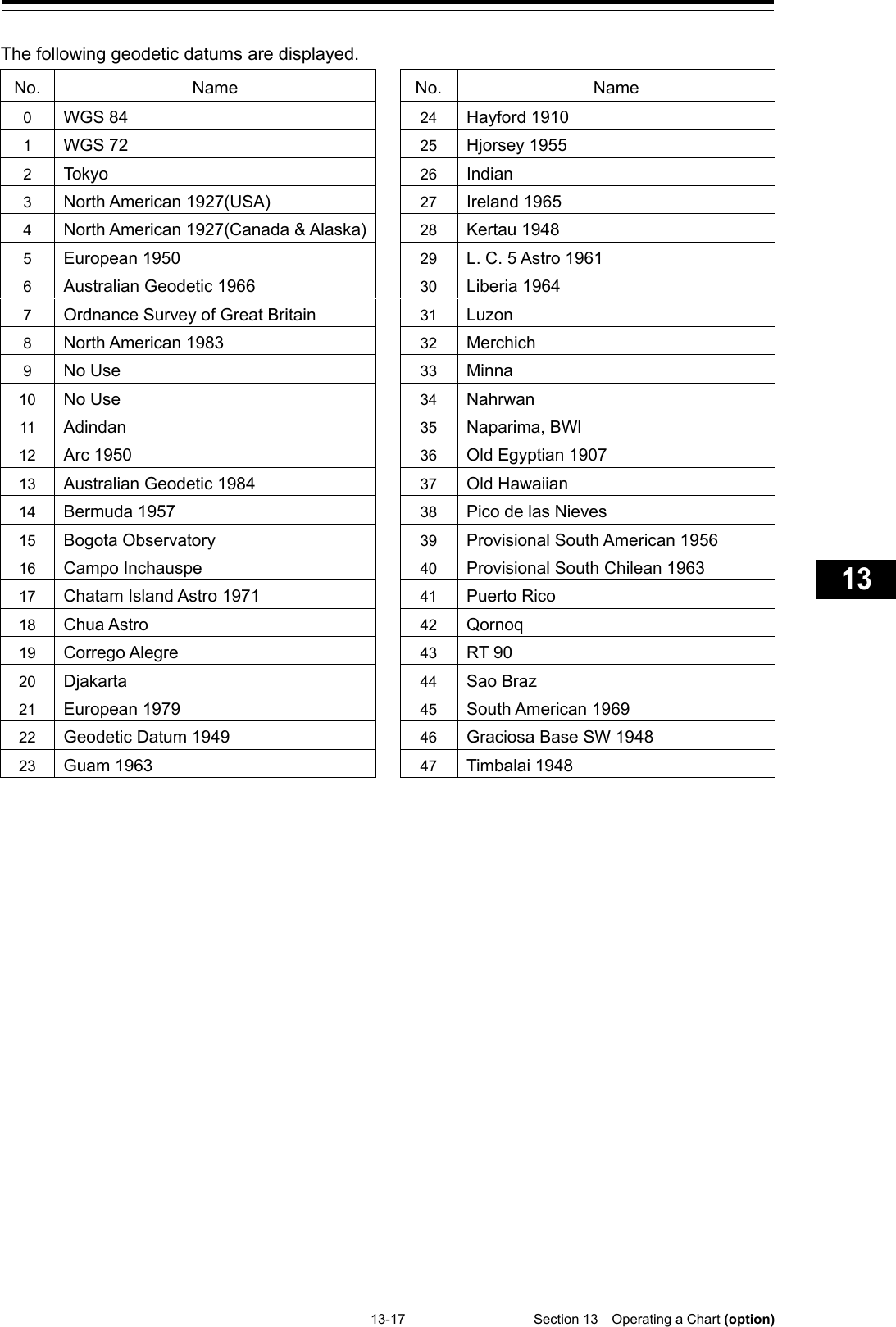
![Section 13 Operating a Chart (option) 13-18 4 Enter a latitude and a longitude in the [Position] input boxes of [Reference Position]. When the [Ship Position] button is clicked on, the latitude and the longitude of the own ship’s position is displayed in the [Position] input boxes. When the [by Cursor] button is clicked on, the cursor changes to the offset cursor. When the mouse button is clicked on the chart, the latitude and longitude of the point on which the mouse button was clicked is displayed in the input boxes. Information after transformation is displayed on [Chart Shift].](https://usermanual.wiki/Japan-Radio-Co/NKE2632.Instruction-Manual-Funtion-Part-5/User-Guide-2791066-Page-52.png)
![13-19 Section 13 Operating a Chart (option) 1 2 3 4 5 6 7 8 9 10 11 12 13 14 15 16 17 18 19 20 21 22 23 24 25 26 27 付録 The position shifted after geodetic datum transformation is displayed in [Reference Position]. The offset amount after geodetic datum transformation is displayed in [Shifted Position]. 5 Click on the [OK] button. The transformation is determined.](https://usermanual.wiki/Japan-Radio-Co/NKE2632.Instruction-Manual-Funtion-Part-5/User-Guide-2791066-Page-53.png)
![Section 13 Operating a Chart (option) 13-20 13.9 Displaying a Chart Abbreviation List A list describing chart abbreviations can be displayed. 1 Click on the [Menu] button on the left toolbar. The menu is displayed. 2 Click on the [Chart] - [Chart Abbreviation] on the menu. The "Chart Abbreviation" dialog box appears.](https://usermanual.wiki/Japan-Radio-Co/NKE2632.Instruction-Manual-Funtion-Part-5/User-Guide-2791066-Page-54.png)
![13-21 Section 13 Operating a Chart (option) 1 2 3 4 5 6 7 8 9 10 11 12 13 14 15 16 17 18 19 20 21 22 23 24 25 26 27 付録 13.10 Maintaining a Chart Use the Chart Maintenance menu for management of chart data. 1 Click on the [Menu] button on the left toolbar. The menu is displayed. In the case of ECDIS: Change over to the second page using the page switching button. 2 Click on the [Chart Maintenance] button on the menu. RADAR ECDIS The "Chart Maintenance" dialog box appears. Three icons are assigned in the "Chart Maintenance" dialog box. Only the Check Status icon can be clicked. Click on the Check Status icon when checking the status of the chart. Note "Import/Update Licence file" and "Import/Update charts" dialogs can also be operated by clicking from the "Chart Maintenance" dialog box started in the task menu.](https://usermanual.wiki/Japan-Radio-Co/NKE2632.Instruction-Manual-Funtion-Part-5/User-Guide-2791066-Page-55.png)
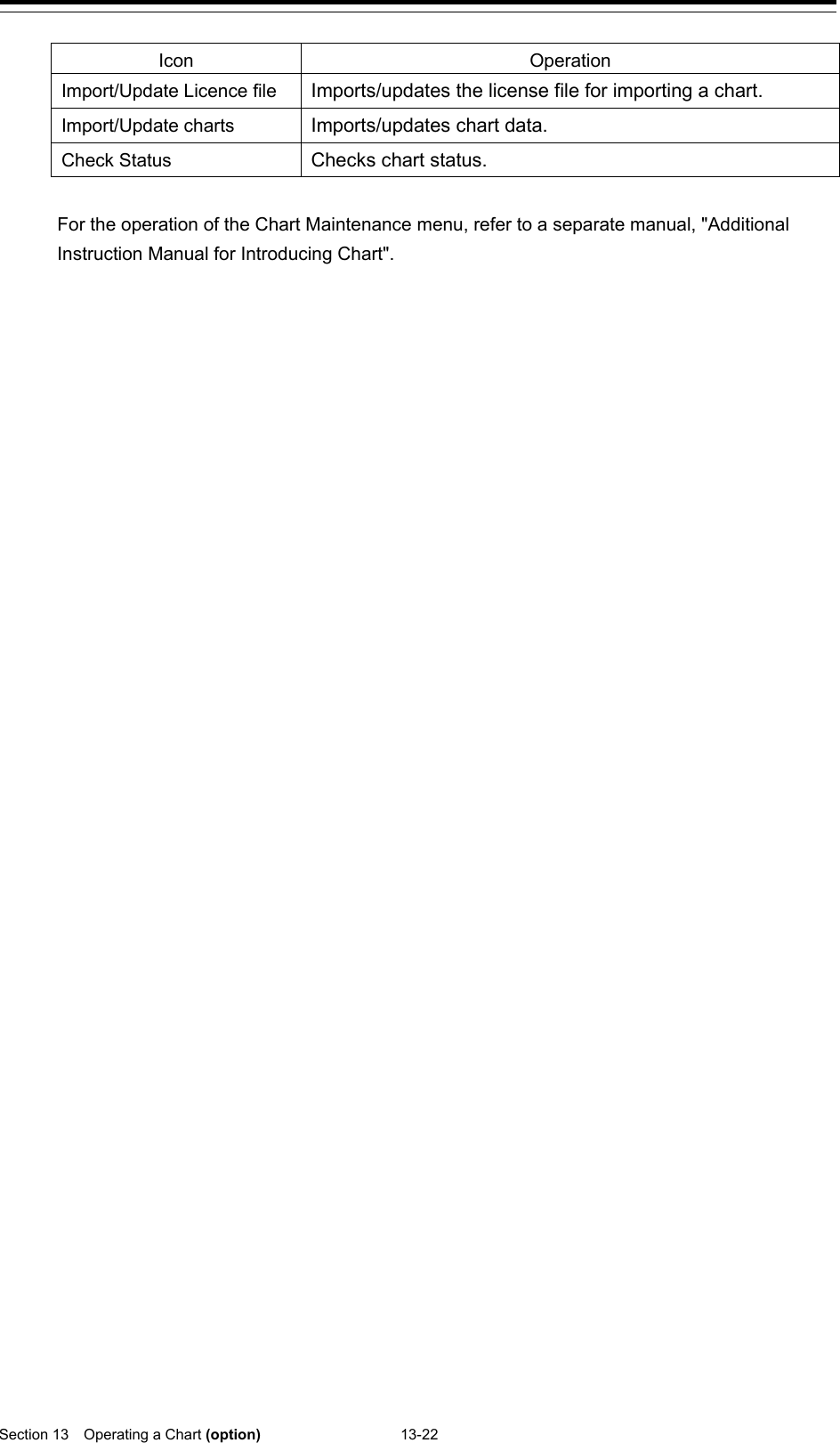
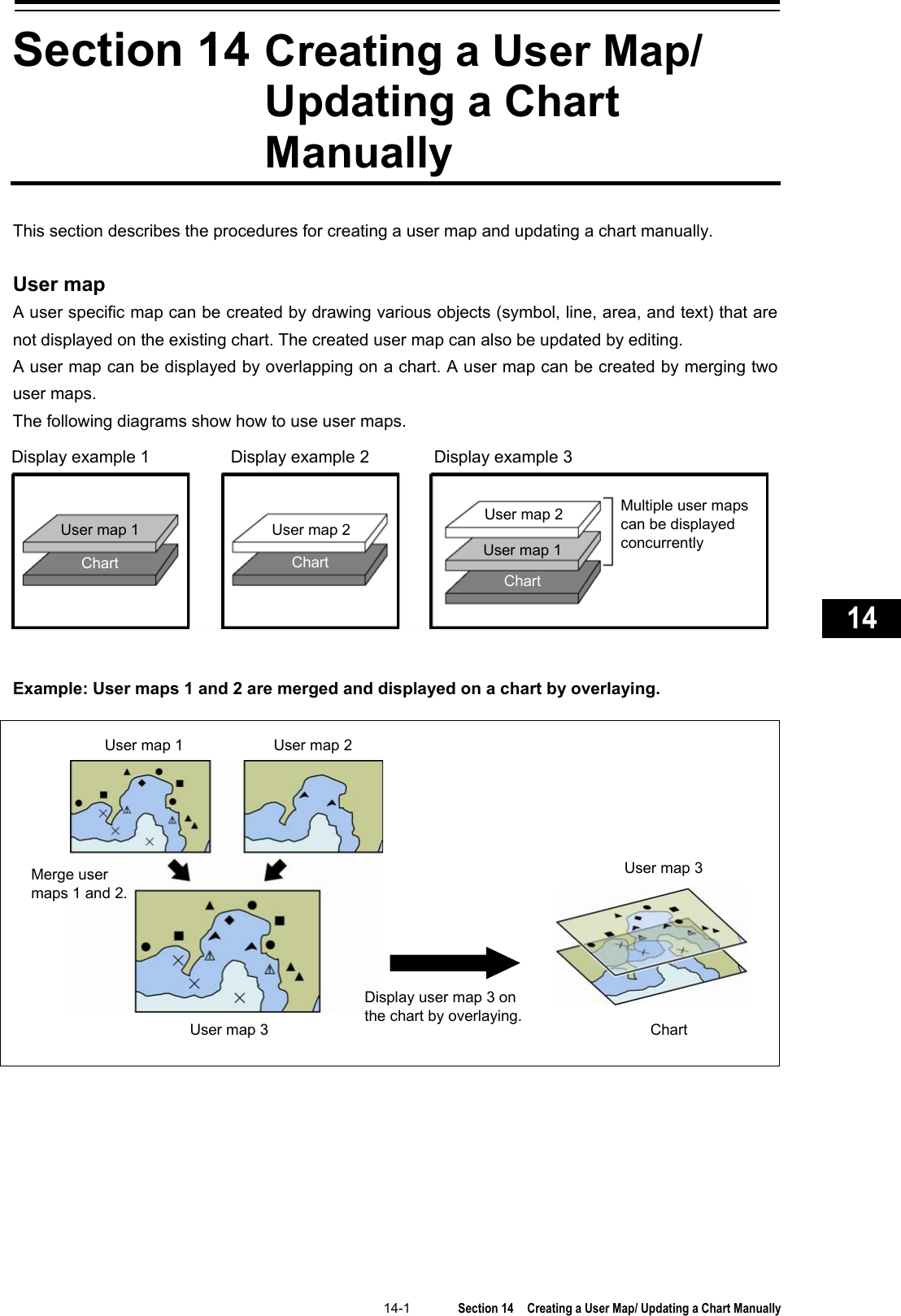
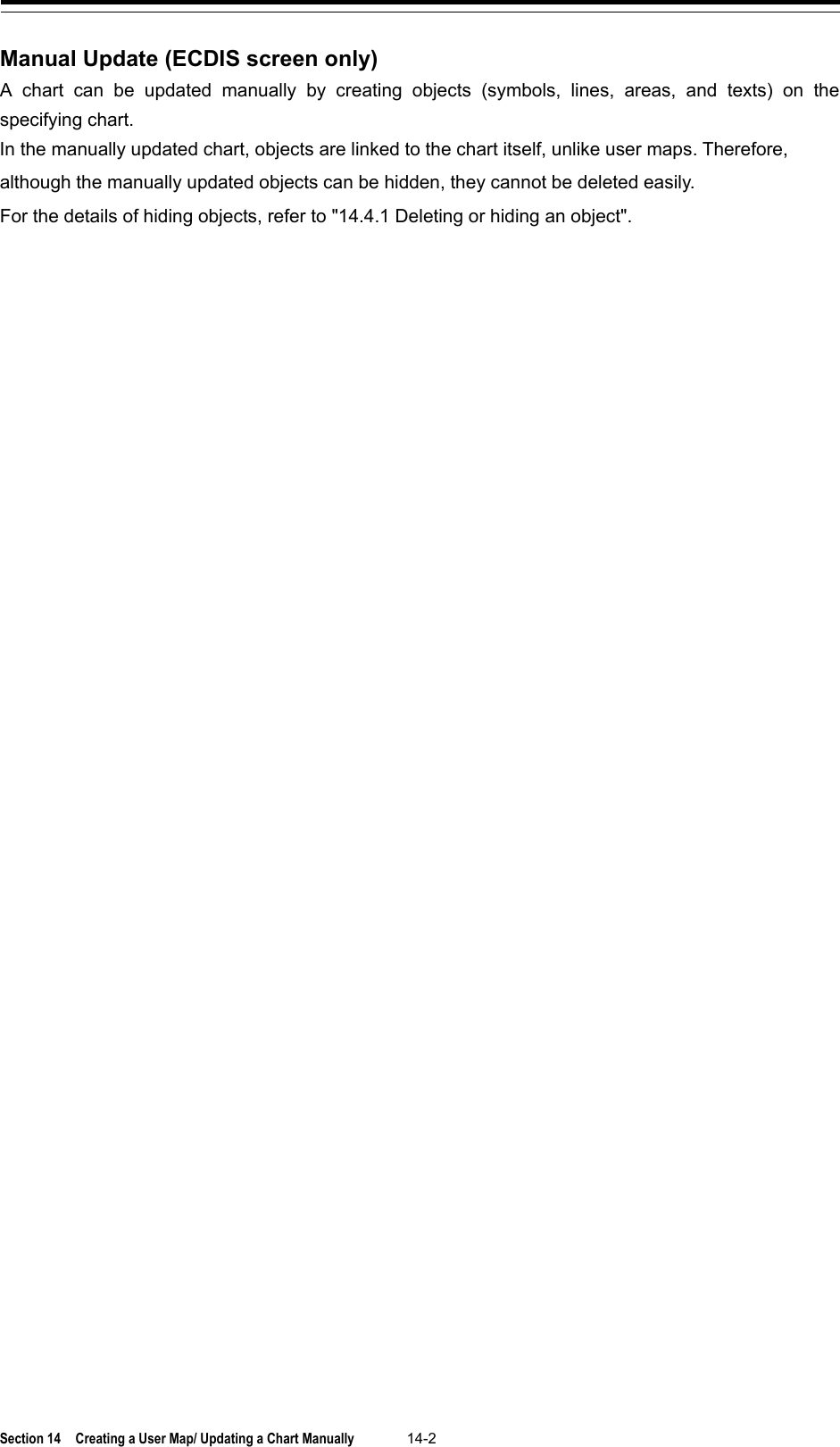
![14-3 Section 14 Creating a User Map/ Updating a Chart Manually 1 2 3 4 5 6 7 8 9 10 11 12 13 14 15 16 17 18 19 20 21 22 23 24 25 26 27 14.1 Creating/Editing a User Map Use the following procedure to create/edit a user map. 1 Displaying the "User Map" menu. Reference: "14.1.1 Display the "User Map" menu". 2 Displaying the "File Operation" submenu. Reference: "14.1.2 Display the File Operation submenu". 3 Registering a new user map file. Reference: "14.1.3 Creating a new user map". 3 Invoking an existing user map file. Reference: "14.1.4 Editing the existing user map". 4 Creating/editing a user map by using map creation tools. Reference: "14.2 Using Map Creation Tools (User Map Creation/Editing)". Creating an object Deleting an object Reference: "14.6 Collective Deletion of Objects [Delete by Type/Color]". Managing/editing an object Reference: "14.7 Managing/Editing Objects [Mark Line/List]". Moving an object Reference: "14.2.10 Moving an object".](https://usermanual.wiki/Japan-Radio-Co/NKE2632.Instruction-Manual-Funtion-Part-5/User-Guide-2791066-Page-59.png)
![Section 14 Creating a User Map/ Updating a Chart Manually 14-4 14.1.1 Display the "User Map" menu. When creating/editing a user map, use the "User Map" menu. 1 Click on the [Menu] button on the left toolbar. The menu is displayed. 2 Click on the [User Map] button on the menu. The submenu is displayed. The User Map menu comprises the following submenus. Submenu Function File Operation • Managing user map files (new creation, loading, copying, deletion, import/export, geodetic conversion) • Displaying/editing a user map • Merging user map files Refer to "14.1.6 Operating a user map file". Delete by Type/Color Deleting objects collectively Refer to "14.6 Collective Deletion of Objects [Delete by Type/Color]". Mark Line/List Managing/editing objects Refer to "14.7 Managing/Editing Objects [Mark Line/List]".](https://usermanual.wiki/Japan-Radio-Co/NKE2632.Instruction-Manual-Funtion-Part-5/User-Guide-2791066-Page-60.png)
![14-5 Section 14 Creating a User Map/ Updating a Chart Manually 1 2 3 4 5 6 7 8 9 10 11 12 13 14 15 16 17 18 19 20 21 22 23 24 25 26 27 14.1.2 Display the File Operation submenu 1 Click on the [Menu] button on the left toolbar. The menu is displayed. 2 Click on the [User Map] button on the menu. 3 Click on the [File Operation] button on the submenu. The "File Operation" operation dialog box appears. 14.1.2.1 "File Operation" dialog box Manage the file at user map creation and display and edit the user map on the "File Operation" dialog box. The user map files that are currently saved are displayed in the file list. The number of objects that are displayed is indicated at the bottom right corner of the dialog. File list Operation guide No. of objects displayed [Merge Display Files] button [Geodetic] button File operation button [Edit User Map] button](https://usermanual.wiki/Japan-Radio-Co/NKE2632.Instruction-Manual-Funtion-Part-5/User-Guide-2791066-Page-61.png)
![Section 14 Creating a User Map/ Updating a Chart Manually 14-6 File list Up to 500 user map files (.uchm) can be registered in a file list. The following information is displayed for the user map files that are currently saved. Item Information [Name] Indicates the name of the user map file (up to 64 characters). The name can be changed by clicking on the name in the list. [Count] Indicates the total number of objects that are registered in the user map file. [Comment] Indicates the comment on the user map file (up to 64 characters). The comment can be changed by clicking on the comment in the list. [Date] Last update date of the user map file [Geodetic] Displays the geodetic datum of the user map file. To change the geodetic datum, refer to "14.1.6.6 Performing geodetic datum conversion". [Display] The [Display] check box is checked for the user map file that is displayed. For the method of using the [Display] check box, refer to "14.1.5 Displaying a user map". [Editing] The [Editing] button is set to ON for the user map file that is being created or edited. For the method of using the [Editing] button, refer to "14.1.4 Editing the existing user map". File operation buttons Button name Function [New] Creates a new user map file. For the details, refer to "14.1.3 Creating a new user map". [Delete] Deletes a user map file. For the details, refer to "14.1.6.1 Deleting a user map file". [Copy] Copies a user map file For the details, refer to "14.1.6.2 Copying a user map file". [Import] Imports a user map file from an external medium. For the details, refer to "14.1.6.3 Importing a user map file". [Export] Exports the user map that was created to an external medium. For the details, refer to "14.1.6.4 Exporting a user map file". [Merge Display Files] button This button merges the selected user map files. For the details, refer to "14.1.6.5 Merging multiple user map files".](https://usermanual.wiki/Japan-Radio-Co/NKE2632.Instruction-Manual-Funtion-Part-5/User-Guide-2791066-Page-62.png)
![14-7 Section 14 Creating a User Map/ Updating a Chart Manually 1 2 3 4 5 6 7 8 9 10 11 12 13 14 15 16 17 18 19 20 21 22 23 24 25 26 27 [Geodetic] button This button selects the geodetic datum of the user map file. For the details, refer to "14.1.6.6 Performing geodetic datum conversion". [Edit User Map] button This button edits the existing user map file. For the details, refer to "14.1.4 Editing the existing user map". 14.1.3 Creating a new user map 1 Click on the [Menu] button on the left toolbar. The menu is displayed. 2 Click on the [User Map] button on the menu. 3 Click on the [File Operation] button on the submenu. The "File Operation" operation dialog box appears. 4 Click on the [New] button. The new user map file is registered in the file list. The file name can be changed by clicking on the file name that is displayed in the [Name] column in the file list. 5 Click on the [Edit User Map] button in the [File Operation] dialog box. The map creation tool is displayed. Create or edit the user map by using the map creation tool. (Refer to "14.2 Using Map Creation Tools (User Map Creation/Editing)"). [New] button [Edit User Map] button](https://usermanual.wiki/Japan-Radio-Co/NKE2632.Instruction-Manual-Funtion-Part-5/User-Guide-2791066-Page-63.png)
![Section 14 Creating a User Map/ Updating a Chart Manually 14-8 14.1.4 Editing the existing user map 1 Click on the [Menu] button on the left toolbar. The menu is displayed. 2 Click on the [User Map] button on the menu. 3 Click on the [File Operation] button on the submenu. The "File Operation" operation dialog box appears. 4 Click on the [Editing] button of the user map file to be edited in the file list on the [File Operation] dialog. The user map file to be edited is displayed. 5 Click on the [Edit User Map] button on the [File Operation] dialog box. The map creation tools (drawing toolbar and the user map information bar) are displayed and the cursor changes from the cross-hair cursor to the mark cursor. Edit the user map by using the map creation tools. (Refer to "14.2 Using Map Creation Tools (User Map Creation/Editing)"). 14.1.4.1 Editing the user map that is currently displayed 1 Display a user map. (Refer to "14.1.5 Displaying a user map"). 2 Click on the Write tool button on the left toolbar. The map creation tools (drawing toolbar and the user map information bar) are displayed and the cursor changes from the cross-hair cursor to the mark cursor. 3 Edit the user map by using the map creation tools. (Refer to "14.2 Using Map Creation Tools (User Map Creation/Editing)"). [Edit User Map] button [Editing] button File list](https://usermanual.wiki/Japan-Radio-Co/NKE2632.Instruction-Manual-Funtion-Part-5/User-Guide-2791066-Page-64.png)
![14-9 Section 14 Creating a User Map/ Updating a Chart Manually 1 2 3 4 5 6 7 8 9 10 11 12 13 14 15 16 17 18 19 20 21 22 23 24 25 26 27 4 To edit another user map, click on the “File Operation” dialog display button on the user map information bar. (Refer to "14.2 Using Map Creation Tools (User Map Creation/Editing)"). The “File Operation” dialog box appears. 5 Click on the [Editing] button of the user map file to be edited in the file list on the “File Operation” dialog box. The selected user map is displayed. 14.1.5 Displaying a user map 1 Click on the [Menu] button on the left toolbar. The menu is displayed. 2 Click on the [User Map] button on the menu. 3 Click on the [File Operation] button on the submenu. The "File Operation" dialog box appears. [Edit User Map] button [Editing] button File list [Display] check box File list](https://usermanual.wiki/Japan-Radio-Co/NKE2632.Instruction-Manual-Funtion-Part-5/User-Guide-2791066-Page-65.png)
![Section 14 Creating a User Map/ Updating a Chart Manually 14-10 4 Select the [Display] check box of the user map file to be displayed in the file list on the [File Operation] dialog box. The selected user map is displayed. 14.1.6 Operating a user map file Manage the file at user map creation, merge user maps, or select a geodetic datum on the "File Operation" dialog box. 14.1.6.1 Deleting a user map file 1 Click on the user map file to be deleted in the file list. The user map file is selected. 2 Click on the [Delete] button. The selected user map file is deleted. 14.1.6.2 Copying a user map file 1 Click on the file to be copied in the file list. The user map file is selected. 2 Click on the [Copy] button. The selected user map file is copied. The copied file is named under "Copy of (copy source file name)". Note If the file name exceeds 64 characters including "Copy of", the file cannot be copied.](https://usermanual.wiki/Japan-Radio-Co/NKE2632.Instruction-Manual-Funtion-Part-5/User-Guide-2791066-Page-66.png)
![14-11 Section 14 Creating a User Map/ Updating a Chart Manually 1 2 3 4 5 6 7 8 9 10 11 12 13 14 15 16 17 18 19 20 21 22 23 24 25 26 27 14.1.6.3 Importing a user map file 1 Click on the [Import] button. A file selection window is displayed. 2 Select and import a user map file that is saved in the external medium on the file selection window. Note When sufficient free storage space is not available in the import destination, a message dialog box is displayed. Change the import destination or import a file after securing sufficient free space. 14.1.6.4 Exporting a user map file 1 Click on the file to be exported from the file list. 2 Click on the [Export] button. A file selection window is displayed. 3 Specify an export destination and export the selected file.](https://usermanual.wiki/Japan-Radio-Co/NKE2632.Instruction-Manual-Funtion-Part-5/User-Guide-2791066-Page-67.png)
![Section 14 Creating a User Map/ Updating a Chart Manually 14-12 When the export destination contains a file of the same name, a message dialog box is displayed, prompting the verification of whether the existing file is to be overwritten. When exporting the file by overwriting the existing one, click on the [OK] button. Note When sufficient free storage space is not available in the export destination, a message dialog box is displayed. Change the export destination or import a file after securing sufficient free space. 14.1.6.5 Merging multiple user map files 1 Select the [Display] check boxes of the files to be merged in the file list. The user map files to be merged are displayed. 2 Click on the [Merge Display Files] button. A user map file is created by merging the user maps that are being displayed. The user map file is named under "Merged User Map Filexxx" (xxx: serial number starting from 001). User Map User Map "USER-02" User Map "USER-01" Two user maps can be merged into one user map.](https://usermanual.wiki/Japan-Radio-Co/NKE2632.Instruction-Manual-Funtion-Part-5/User-Guide-2791066-Page-68.png)
![14-13 Section 14 Creating a User Map/ Updating a Chart Manually 1 2 3 4 5 6 7 8 9 10 11 12 13 14 15 16 17 18 19 20 21 22 23 24 25 26 27 14.1.6.6 Performing geodetic datum conversion It is possible to use the preset datum or convert the datum by entering an offset value. 1 Click on the user map file whose geodetic datum is to be converted on the file list. The user map file is selected. 2 Click on the [Geodetic] button. The "Geodetic Conversion" window appears. 3 To use the preset geodetic datum, click on the [Select Geodetic] button and click on the geodetic datum on the list. When entering an offset value, click on the [Enter Offset] button and enter a numeric value. Note When [No Use] is selected on the [Select Geodetic] list, geodetic datum conversion is not performed. 4 Click on the [OK] button. Geodetic datum conversion is executed based on the setting in Step 3.](https://usermanual.wiki/Japan-Radio-Co/NKE2632.Instruction-Manual-Funtion-Part-5/User-Guide-2791066-Page-69.png)
![Section 14 Creating a User Map/ Updating a Chart Manually 14-14 14.2 Using Map Creation Tools (User Map Creation/Editing) Use the map creation tools to create/edit a user map or update a chart manually. The following tools can be used for user map creation. Note The map creation tool configuration and functions vary depending on whether a chart is edited manually or a user map is created. For the details, refer to "14.4 How to Use the Map Creation Tools (for Manual Update)" 14.2.1 User map information bar The user map information bar is located at the bottom right corner of the screen and displays the user map name that is currently being created/edited. The "File Operation" dialog box can be displayed by clicking on the "File Operation" dialog box display button. 14.2.1.1 Displaying a user map information bar 1 Select [User Map] - [File Operation] on the menu. 2 Click on the [Edit User Map] button on the "File Operation" dialog box that is displayed. The user map information bar can also be displayed by clicking on the write tool button on the left toolbar. Object property dialog box User map information bar Drawing toolbar Name of user map currently edited File Operation dialog box display button](https://usermanual.wiki/Japan-Radio-Co/NKE2632.Instruction-Manual-Funtion-Part-5/User-Guide-2791066-Page-70.png)
![14-15 Section 14 Creating a User Map/ Updating a Chart Manually 1 2 3 4 5 6 7 8 9 10 11 12 13 14 15 16 17 18 19 20 21 22 23 24 25 26 27 14.2.2 Drawing toolbar Display a drawing toolbar by clicking on the drawing tool button on the left toolbar. Note At user map creation, the azimuth mode is fixed to the [N UP] mode. The drawing toolbar comprises the following tool buttons. The buttons that are assigned vary according to the object type (Symbol/Line/Area/Text) that is currently selected. Drawing tool button [Type] button [Color] button [EBL/VRM] button [Enter POSN] button [Type] button [Line] button [Fill] button [EBL/VRM] button [Enter POSN] button Drawing toolbar when symbol/text is selected At creation of a user map, "U.Map" is displayed on the drawing tool button. [Type] button [Line] button [EBL/VRM] button [Enter POSN] button Drawing toolbar when line is selected. Drawing toolbar when area is selected](https://usermanual.wiki/Japan-Radio-Co/NKE2632.Instruction-Manual-Funtion-Part-5/User-Guide-2791066-Page-71.png)
![Section 14 Creating a User Map/ Updating a Chart Manually 14-16 Tool button Function [Type] button Displays an icon list. (Refer to "14.2.3 Selecting an object type".). [Color] button (Symbol/text selection) Select the color of the symbol/text. (Refer to "14.2.4 Selecting a color of an object".). [Line] button Enables selection of a color of the line that forms the object. (Refer to "14.2.4 Selecting a color of an object".). [Fill] button (at area selection only) Enables selection of a color of the area that forms the object. (Refer to "14.2.4 Selecting a color of an object".). [EBL/VRM] button Switches the cursor mode of the user map creation function to the EBL/VRM mode. (Refer to "14.2.5 Creating an object in the EBL/VRM mode".). [Enter POSN] (“Enter Position” dialog display) button Displays the "Enter Position" dialog (Refer to "14.2.6 Creating an object by specifying latitude and longitude".). 14.2.3 Selecting an object type By displaying an icon list, the type of the Mariner's Mark/Line object or the user map object ([Symbol], [Line], [Area], and [Text]) can be selected. 1 Click on the [Type] button on the drawing toolbar. An icon list is displayed. 2 Select a type of the object by clicking on the icon in the icon list. The icon list can be switched to thumbnail display or list display by clicking on the thumbnail/list display switching button. For the icons that can be selected from the icon list, refer to "Appendix D.5 Icon Button List for User Map". Icon list Thumbnail/list display switching button Mariner's Mark/Line menu User map menu Icon list (thumbnail display) Icon list (list display)](https://usermanual.wiki/Japan-Radio-Co/NKE2632.Instruction-Manual-Funtion-Part-5/User-Guide-2791066-Page-72.png)
![14-17 Section 14 Creating a User Map/ Updating a Chart Manually 1 2 3 4 5 6 7 8 9 10 11 12 13 14 15 16 17 18 19 20 21 22 23 24 25 26 27 14.2.3.1 Using a user map object Select a type of the object (symbol/line/area/text) to be displayed in the icon list by clicking on a user map menu button. The following objects are displayed. Button Icons displayed [Symbol] button Circle Triangle Square Diamond Multiple Mark Warning symbol [Line] button Simple line(solid line) Simple line(dotted line) Simple line(dashed line) Circle(solid line) Circle(dotted line) Circle(dashed line) Ellipse(solid line) Ellipse(dotted line) Ellipse(dashed line) Arc(solid line) Arc(dotted line) Arc(dashed line) Warning line Arrow(Start To End/Small) Arrow(Start To End/Medium) Arrow(Start To End/Large) Arrow(End To Start/Small) Arrow(End To Start/Medium) Arrow(End To Start/Large) Arrow(Both Direct/Small) Arrow(Both Direct/Medium) Arrow(Both Direct/Large)](https://usermanual.wiki/Japan-Radio-Co/NKE2632.Instruction-Manual-Funtion-Part-5/User-Guide-2791066-Page-73.png)
![Section 14 Creating a User Map/ Updating a Chart Manually 14-18 Button Icons displayed [Area] button Polygon(solid line) Polygon(dotted line) Polygon(dashed line) Circle(solid line) Circle(dotted line) Circle(dashed line) Ellipse(solid line) Ellipse(dotted line) Ellipse(dashed line) Fan(solid line) Fan(dotted line) Fan(dashed line) Warning area(solid line) Warning area(dotted line) Warning area(dashed line) [Text] button Te xt 14.2.4 Selecting a color of an object 1 When selecting a color of the symbol/text object on the drawing toolbar, click on the [Color] button. To select a line color of an area object, click on the [Line] button. To select a color for filling an area object, click on the [Fill] button. 2 Select and click on the required color on the list that is displayed. The following 10 colors are available. • White/Black (The color changes to White/Black under the following conditions. RADAR screen: Always White ECDIS screen: Day1/Day2: Black, Day3/Dusk/Night: White) • Gray • Amber • Magenta • Blue • Cyan • Green • Yellow • Orange • Dark Red](https://usermanual.wiki/Japan-Radio-Co/NKE2632.Instruction-Manual-Funtion-Part-5/User-Guide-2791066-Page-74.png)
![14-19 Section 14 Creating a User Map/ Updating a Chart Manually 1 2 3 4 5 6 7 8 9 10 11 12 13 14 15 16 17 18 19 20 21 22 23 24 25 26 27 14.2.5 Creating an object in the EBL/VRM mode 1 Click on the [EBL/VRM] button on the drawing toolbar. The user map creation function mode is switched from the cursor mode to the EBL/VRM mode. When the mode is switched to the EBL/VRM mode, the cursor changes to the following state. The EBL/VRM mode is switched to cursor mode when the right mouse button is clicked on the chart or the [Enter POSN] button on the drawing toolbar is clicked on 14.2.6 Creating an object by specifying latitude and longitude Using the "Enter Position" dialog box, it is possible to create an object at the specified latitude and longitude. Displaying the "Enter Position" dialog box 1 Click on the [Enter POSN] button on the drawing toolbar. Note An object cannot be created with the cursor mode and EBL/VRM mode while this dialog box is displayed. EBL/VRM base point cursor "Enter Position" dialog box](https://usermanual.wiki/Japan-Radio-Co/NKE2632.Instruction-Manual-Funtion-Part-5/User-Guide-2791066-Page-75.png)
![Section 14 Creating a User Map/ Updating a Chart Manually 14-20 14.2.6.1 Creating an object of symbol/circle/ellipse/arc/arrow/text Enter latitude and longitude values of the object in the [Position] box and click on the [Enter] button. The [Bearing] box, [Distance] box, and the [New] button are disabled. 14.2.6.2 Creating an object of simple line/polygon/highlight Use the following procedure to create an object with vertices such as a simple line, polygon, and highlight. 1 Enter latitude and longitude values of a vertex of the object in the [Position] box and click on the [Enter] button. The position of one of the vertices of the object is determined. The [Bearing] box and the [Distance] box are enabled. 2 Enter latitude and longitude values of the next vertex in the [Position] box. Alternatively, in the [Bearing] box and the [Distance] box, enter the bearing and distance from the previous vertex that was determined. 3 Click on the [Enter] button. 4 Repeat Steps 2 and 3. A simple line can be determined by two or more vertices and a polygon/highlight can be determined by three or more vertices. 5 To create a next object continuously, click on the [New] button. 14.2.7 Deleting an object 1 Click on the eraser tool button on the left toolbar. The cursor changes to the eraser cursor. 2 Place the cursor on the eraser cursor and click the mouse button. When the right button is clicked on any position with the eraser cursor, the cursor mode is reset to the cross-hairs cursor. Objects of the same shape or color can be deleted collectively. For the details, refer to "14.6 Collective Deletion of Objects [Delete by Type/Color]".](https://usermanual.wiki/Japan-Radio-Co/NKE2632.Instruction-Manual-Funtion-Part-5/User-Guide-2791066-Page-76.png)
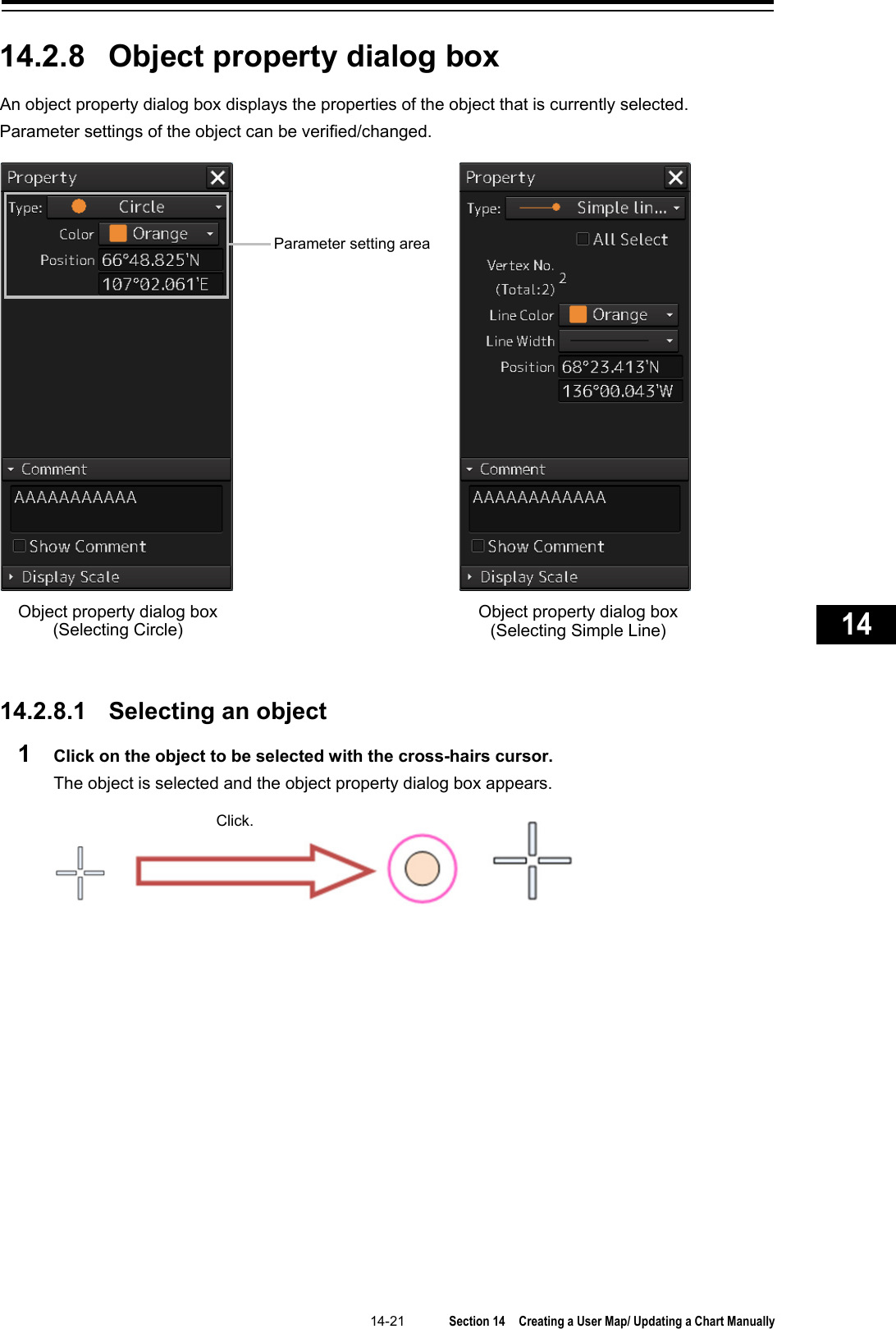
![Section 14 Creating a User Map/ Updating a Chart Manually 14-22 14.2.8.2 Setting a comment In the object property dialog box, a comment for the object can be entered. When the [Show Comment] check box is selected, a comment can be displayed on the user map. 1 Enter a comment in the [Comment] box (up to 64 characters). 2 To display the comment that is input on the user map, select the [Show Comment] check box. [Comment] text box [Show Comment] check box](https://usermanual.wiki/Japan-Radio-Co/NKE2632.Instruction-Manual-Funtion-Part-5/User-Guide-2791066-Page-78.png)
![14-23 Section 14 Creating a User Map/ Updating a Chart Manually 1 2 3 4 5 6 7 8 9 10 11 12 13 14 15 16 17 18 19 20 21 22 23 24 25 26 27 14.2.9 Changing an object display scale range An object display scale range (1:1 to 1:100,000,000) can be changed on the object property dialog box. 1 Select a minimum scale on the [MIN scale] combo box. 2 Select a maximum scale on the [MAX scale] combo box. 14.2.10 Moving an object To move an object, use the context menu that is displayed by clicking the right button on the object. 1 When the object to be moved is in the selected state, unselect the object. To unselect the object, click on a section without display or another object. 2 Click the right button on the object. The object is selected and the context menu is displayed. [Display Scale] setting section EditRight-click](https://usermanual.wiki/Japan-Radio-Co/NKE2632.Instruction-Manual-Funtion-Part-5/User-Guide-2791066-Page-79.png)
![Section 14 Creating a User Map/ Updating a Chart Manually 14-24 3 Click on [Move this object]. 4 Click on the position to which the object is to be moved. The selected object moves to the position on which the button was clicked.](https://usermanual.wiki/Japan-Radio-Co/NKE2632.Instruction-Manual-Funtion-Part-5/User-Guide-2791066-Page-80.png)
![14-25 Section 14 Creating a User Map/ Updating a Chart Manually 1 2 3 4 5 6 7 8 9 10 11 12 13 14 15 16 17 18 19 20 21 22 23 24 25 26 27 14.3 Updating a Chart Manually (ECDIS Screen Only) Use the following procedure to update a chart. 1 Display the [Chart] - [Manual Update] menu. Reference: "14.3.1 Displaying the Manual Update submenu" 2 Select a chart to be updated. Reference: "14.3.2 Selecting a chart to be updated" 3 Update the chart manually by using the map creation tools. Reference: "14.3.3 Updating a chart manually" "14.4 How to Use the Map Creation Tools (for Manual Update)" 4 End manual updating or start route planning. Reference: "Section 9 Route Planning" Create an object. Reference: "14.5 Creating an Object" Select display/hide for the object. Reference: "14.3.5 Selecting display/hide for the object" Manage/edit an object. Reference: "14.7 Managing/Editing Objects [Mark Line/List]" Move an object. Reference: "14.2.10 Moving an object"](https://usermanual.wiki/Japan-Radio-Co/NKE2632.Instruction-Manual-Funtion-Part-5/User-Guide-2791066-Page-81.png)
![Section 14 Creating a User Map/ Updating a Chart Manually 14-26 14.3.1 Displaying the Manual Update submenu By selecting [Menu] - [Chart] - [Manual Update], the selected chart can be updated manually. Note Since a dialog box requesting a Notice to Mariners issuing date is displayed when the updated chart is saved, enter the issuing date. 1 Click on the [Menu] button on the left toolbar. The menu is displayed. 2 Click on the [Chart] button on the menu. 3 Click on the [Manual Update] button on the submenu. The "Manual Update" toolbar is displayed. "Manual Update" toolbar](https://usermanual.wiki/Japan-Radio-Co/NKE2632.Instruction-Manual-Funtion-Part-5/User-Guide-2791066-Page-82.png)
![14-27 Section 14 Creating a User Map/ Updating a Chart Manually 1 2 3 4 5 6 7 8 9 10 11 12 13 14 15 16 17 18 19 20 21 22 23 24 25 26 27 14.3.2 Selecting a chart to be updated 1 Click on the [Select Chart] button on the Manual Update toolbar. The "Select Chart" dialog box appears. 2 Select a chart file to be updated manually on the [Select Chart] dialog box. 3 Click on the [OK] button in the [Select Chart] dialog box. A chart is selected. Search box [OK] button Chart list [Reset picked chart] button "Select Chart" dialog box](https://usermanual.wiki/Japan-Radio-Co/NKE2632.Instruction-Manual-Funtion-Part-5/User-Guide-2791066-Page-83.png)
![Section 14 Creating a User Map/ Updating a Chart Manually 14-28 14.3.2.1 Searching the position that is clicked on with the cursor 1 Move the cursor to the position where manual update is to be performed and click the button. The chart at the position on which the button was clicked is displayed in the S-57 chart list. Memo To clear the search result, click on the [Reset picked chart] (chart selection reset) button on the [Select Chart] dialog box. 14.3.2.2 Searching a chart with the chart name 1 Enter a chart name in the search box on the [Select Chart] dialog box. The applicable chart is displayed. Memo To clear the search result, clear the input in the search box. 14.3.3 Updating a chart manually 1 By using map creation tools, create/edit an object on a chart. (Refer to "14.2 Using Map Creation Tools (User Map Creation/Editing)"). 2 Delete an object or change the properties as required. (Refer to "14.5 Creating an Object "). 3 Click on the [Save] button. The [Notice to Mariners] dialog box appears. 4 Enter a notice to mariners issuing date in the [Issue date] input box on [Notice to Mariners] dialog by using a software keyboard. 5 Click on the [OK] button in the [Notice to Mariners] dialog box. The manually updated object is saved in the chart. [lssue date] input box [OK] button](https://usermanual.wiki/Japan-Radio-Co/NKE2632.Instruction-Manual-Funtion-Part-5/User-Guide-2791066-Page-84.png)
![14-29 Section 14 Creating a User Map/ Updating a Chart Manually 1 2 3 4 5 6 7 8 9 10 11 12 13 14 15 16 17 18 19 20 21 22 23 24 25 26 27 14.3.4 Displaying the selected chart only 1 Select a chart to be displayed according to the procedure described in "14.3.2 Selecting a chart to be updated". 2 Set the [FIX] button on the Manual Update toolbar to ON. 14.3.5 Displaying the object/redisplaying the hidden object To display all the objects that were created by chart manual update, select the [Display All Object] check box on the Manual Update toolbar. To redisplay the hidden objects, select the [Display Hidden Objects] check box on the Manual Update toolbar. ON OFF](https://usermanual.wiki/Japan-Radio-Co/NKE2632.Instruction-Manual-Funtion-Part-5/User-Guide-2791066-Page-85.png)
![Section 14 Creating a User Map/ Updating a Chart Manually 14-30 14.4 How to Use the Map Creation Tools (for Manual Update) At chart manual update also, use the same map creation tools in the same way as that of user map creation. (Refer to "14.2 Using Map Creation Tools (User Map Creation/Editing)"). However, there are the following differences in the map creation tools • The user map information bar is not displayed. • The object that is saved cannot be deleted by the eraser tool (can be hidden). • A Mariner's Mark/Line drawing object cannot be selected with the drawing tool. • More icon types can be selected in the drawing tool. When the chart is updated manually, "Update" is displayed on the Write tool button. Note At chart manual update, the bearing reference mode is fixed to [N UP] mode. 14.4.1 Deleting or hiding an object 1 Click on the eraser tool button. The cursor changes to the eraser cursor. 2 Place the eraser cursor on the object and click the button. At manual update, only pre-saved objects can be deleted by the eraser tool. If the saved object is clicked on with the eraser tool, the object is hidden. All the property screens of the object that has been set to hide are displayed as disable and cannot be edited. The object that is created and saved by manual update can be redisplayed unless deleted even if it is hidden. If the chart that uses the hidden object is updated, the expiration date of the object is set (90 days from the date on which the object is created). The object will be deleted after the expiration date. Also, the object property dialog box setting can be changed by using the Mark/Line List submenu. For the details, refer to "14.7.4 Displaying a manual update list (ECDIS screen only)".](https://usermanual.wiki/Japan-Radio-Co/NKE2632.Instruction-Manual-Funtion-Part-5/User-Guide-2791066-Page-86.png)
![14-31 Section 14 Creating a User Map/ Updating a Chart Manually 1 2 3 4 5 6 7 8 9 10 11 12 13 14 15 16 17 18 19 20 21 22 23 24 25 26 27 14.4.2 Selecting an object type 1 Click on the [Type] button on the drawing toolbar. An icon list is displayed. 2 Select an object type by clicking on the icon on the icon list. At manual update, the following icon list is displayed. The [Mariner's Mark/Line] button is not displayed on the icon list at manual update. For the details of icons that can be selected from the icon list, refer to "Appendix D.6 Icon Button List for Manual Update". Icon list Category display Icon list at manual update](https://usermanual.wiki/Japan-Radio-Co/NKE2632.Instruction-Manual-Funtion-Part-5/User-Guide-2791066-Page-87.png)
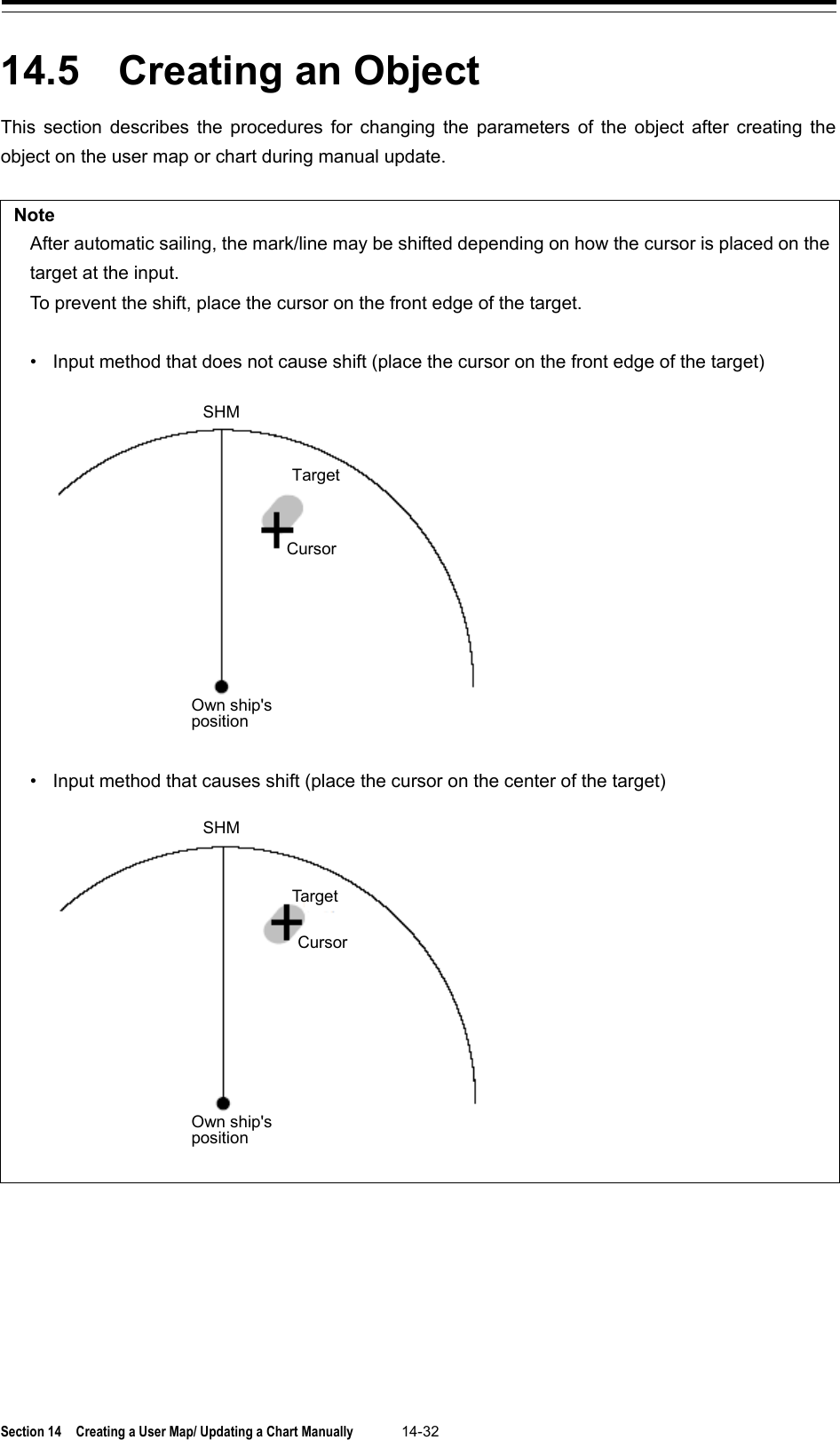
![14-33 Section 14 Creating a User Map/ Updating a Chart Manually 1 2 3 4 5 6 7 8 9 10 11 12 13 14 15 16 17 18 19 20 21 22 23 24 25 26 27 14.5.1 Creating a symbol object (Symbol) A symbol or a Warning symbol can be created by specifying the creation position with the cursor. 1 Click on the [Type] button on the drawing toolbar. An icon list is opened. Select a symbol or an icon of the Warning symbol. (Refer to "14.2.3 Selecting an object type"). 2 Click on the position on which the symbol is to be created with the cursor. The symbol is displayed on the position on which the button is clicked and the parameters of the symbol that was created are displayed on the object property dialog box. 3 Adjust the parameters on the object property dialog box. 4 To create an object on another position continuously, repeat Steps 2 and 3. 14.5.1.1 Creating an object by specifying the latitude and longitude 1 Click on the [Enter POSN] button on the drawing toolbar. The "Enter Position" dialog box appears (Refer to "14.2.6 Creating an object by specifying latitude and longitude). MarkLatitude and longitude of the symbol creation position](https://usermanual.wiki/Japan-Radio-Co/NKE2632.Instruction-Manual-Funtion-Part-5/User-Guide-2791066-Page-89.png)
![Section 14 Creating a User Map/ Updating a Chart Manually 14-34 2 Enter the latitude and longitude of the position on which an object is to be created and click on the [Enter] button. An object is created on the specified latitude and longitude and the property information is reflected in the object property dialog box. (Refer to "14.2.8 Object property dialog box"). 3 Adjust the parameters on the object property dialog box. 4 To create an object on another position continuously, repeat Steps 2 and 3. At user map creation, the symbol size can be changed by selecting [Option] - [User Map] on the View menu. For the details, refer to "16.2.4 Setting up the Display of User Map". 14.5.1.2 Creating an object with EBL/VRM operation 1 Click on the [EBL/VRM] button on the drawing toolbar. The cursor changes to the EBL/VRM reference point cursor. (Refer to "14.2.5 Creating an object in the EBL/VRM mode"). 2 Click on the position of the reference point of the EBL/VRM marker. The EBL/VRM marker is displayed. 3 Place the EBL/VRM marker on the position on which the object is to be created and click the button. An object is created on the position on which the button was clicked and the property information is reflected in the object property dialog box. (Refer to "14.2.8 Object property dialog box"). 4 Adjust the parameters on the object property dialog box. 5 To create an object on another position continuously, repeat Steps 2 to 4.](https://usermanual.wiki/Japan-Radio-Co/NKE2632.Instruction-Manual-Funtion-Part-5/User-Guide-2791066-Page-90.png)
![14-35 Section 14 Creating a User Map/ Updating a Chart Manually 1 2 3 4 5 6 7 8 9 10 11 12 13 14 15 16 17 18 19 20 21 22 23 24 25 26 27 14.5.2 Creating a simple line and a Warning line (Line object) A simple line and a Warning line are created by using one vertex as an object. A Warning line is a line object that is detected as the warning target (danger line) of own ship. Note The color and width of a Warning line cannot be changed. 1 Click on the [Type] button on the drawing toolbar. An icon list is opened. Select an icon of a simple line or a Warning line. (Refer to "14.2.3 Selecting an object type"). 2 Click on the starting point with the cursor. A vertex is created and the property information of the vertex is displayed on the object property dialog box. 3 Move the cursor to the next vertex. The latitude and longitude of the cursor are displayed near the cursor.](https://usermanual.wiki/Japan-Radio-Co/NKE2632.Instruction-Manual-Funtion-Part-5/User-Guide-2791066-Page-91.png)
![Section 14 Creating a User Map/ Updating a Chart Manually 14-36 4 Click on the position on which the 2nd vertex is to be created. A vertex is created and the parameters of the 2nd vertex are displayed on the object property dialog box. Releasing the starting point selection state Addition of 2nd point The property screen is updated after the 2nd position is added. [Type] becomes the medium point. The number of vertices becomes 2. Editing of the line color and width is enabled. The coordinates of the 2nd point are entered.](https://usermanual.wiki/Japan-Radio-Co/NKE2632.Instruction-Manual-Funtion-Part-5/User-Guide-2791066-Page-92.png)
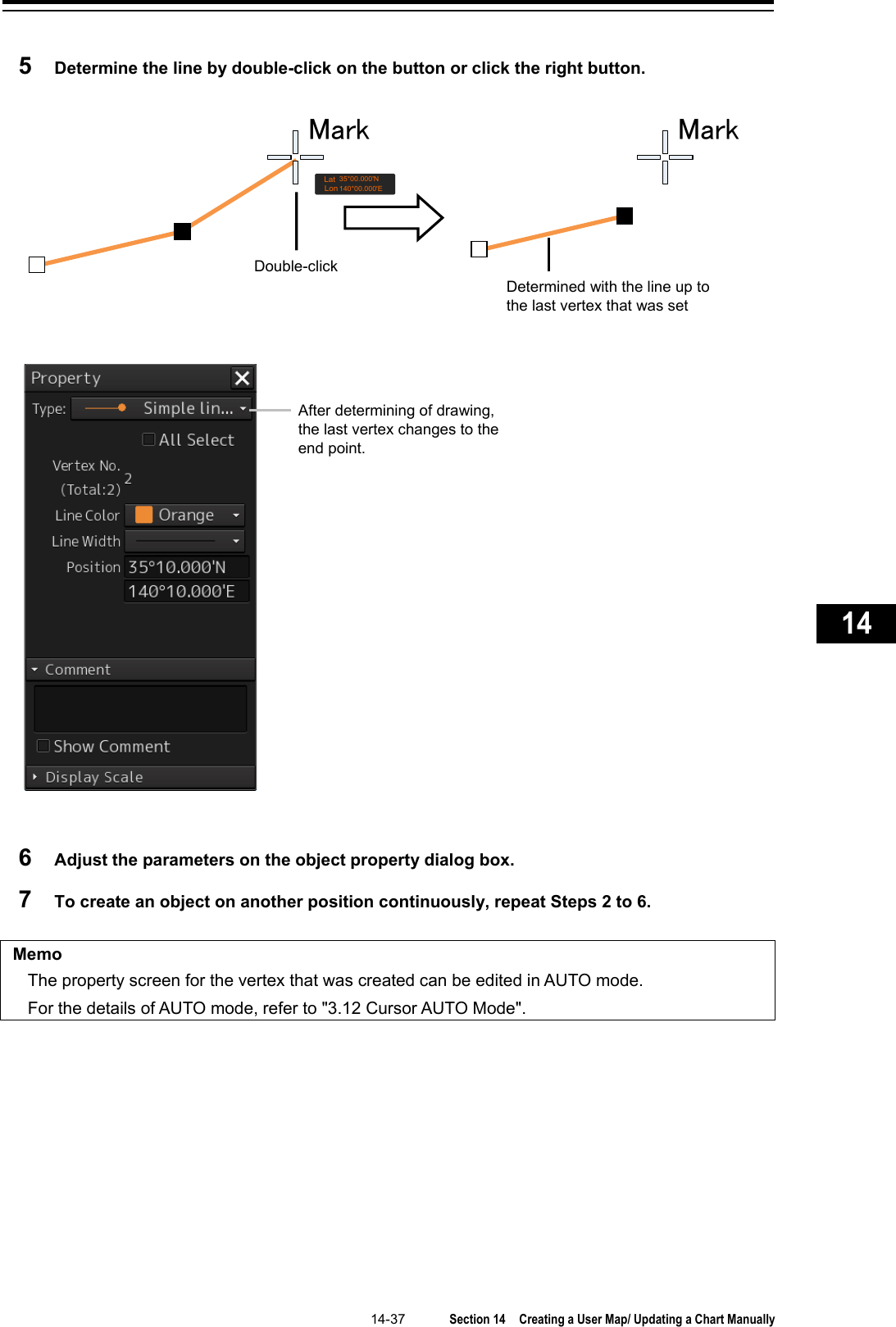
![Section 14 Creating a User Map/ Updating a Chart Manually 14-38 14.5.2.1 Creating a vertex by entering the position 1 Click on the [Enter POSN] button on the drawing toolbar. The "Enter Position" dialog box appears. 2 Enter the latitude and longitude of the vertex of the object in the [Position] box and click on the [Enter] button. The position of the vertex of the object is determined. The [Bearing] box and the [Distance] box are enabled. 3 Enter the values of the latitude and the longitude of the next vertex in the [Position] box. Alternatively, enter the bearing from the vertex that was determined immediately previously in the [Bearing] box and the [Distance] input box. 4 Click on the [Enter] button. 5 Determine the positions of 3 or more vertices by repeating Steps 2 and 3. 6 Adjust the parameters on the object property dialog box. 7 To create an object in another position continuously, click on the [New] button of the "Enter Position" dialog and repeat Steps from 2 to 6. 14.5.2.2 Creating an object with EBL/VRM operation 1 Click on the [EBL/VRM] button on the drawing toolbar. The cursor changes to the EBL/VRM reference point cursor. (Refer to "14.2.5 Creating an object in the EBL/VRM mode"). 2 Click on the position of the reference point of the EBL/VRM marker. The EBL/VRM marker is displayed. 3 Place the EBL/VRM marker on the starting point and click the button. A vertex is created on the position on which the button was clicked and the information is reflected in the object property dialog box. (Refer to "14.2.8 Object property dialog box"). Starting point](https://usermanual.wiki/Japan-Radio-Co/NKE2632.Instruction-Manual-Funtion-Part-5/User-Guide-2791066-Page-94.png)
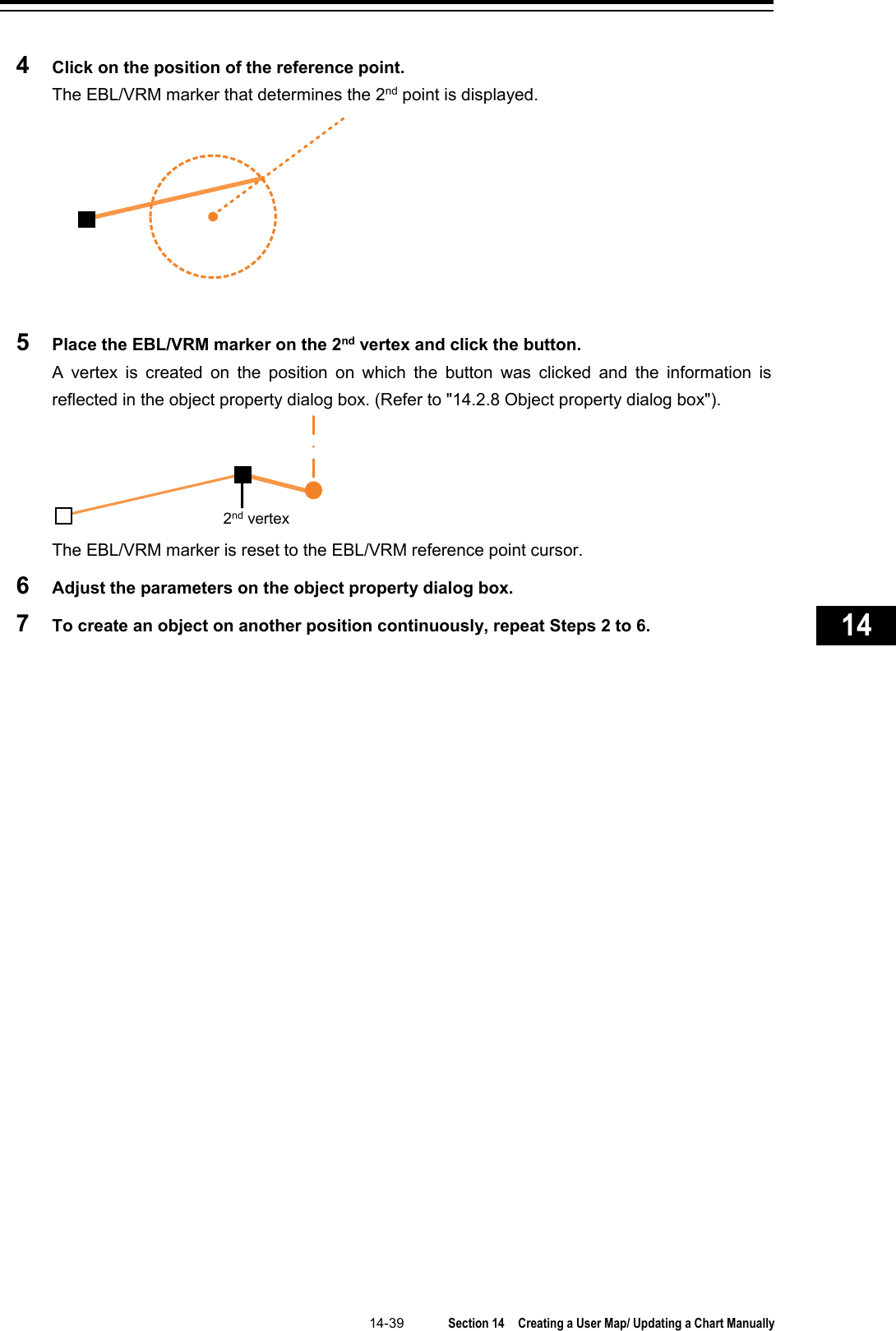
![Section 14 Creating a User Map/ Updating a Chart Manually 14-40 14.5.3 Creating a circle, ellipse, and an arc (Line object) A circle, an ellipse, and arc can be drawn with the cursor by specifying the center. 1 Click on the [Type] button on the drawing toolbar. An icon list is opened. 2 Select an icon of a circle, an ellipse, or an arc. (Refer to "14.2.3 Selecting an object type"). 3 Click on the position for the center with the cursor. The center is created and the property information on the vertex is displayed on the object property dialog box.](https://usermanual.wiki/Japan-Radio-Co/NKE2632.Instruction-Manual-Funtion-Part-5/User-Guide-2791066-Page-96.png)
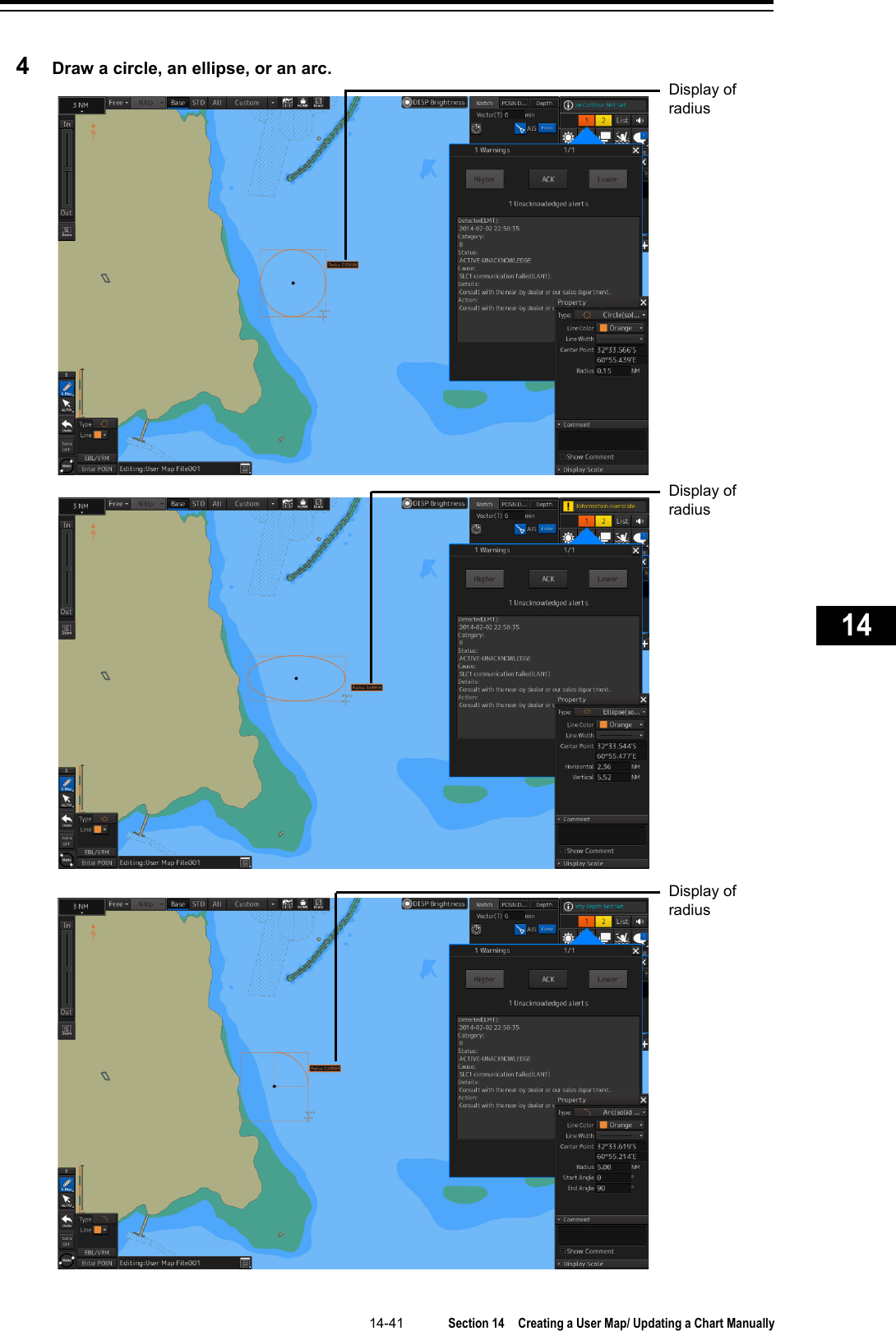
![Section 14 Creating a User Map/ Updating a Chart Manually 14-42 At creation of an arc, the starting angle and the ending angle of the arc to be created are the previous values or the initial values (starting angle: 0°, ending angle: 90°). To change the starting angle and the ending angle, change the values in [Start Angle] and [End Angle] on the object property dialog box. 5 Determine the object by clicking the button again. 6 Adjust the parameters on the object property dialog box. 7 To create an object on another position continuously, repeat Steps 3 to 6. 14.5.3.1 Creating an object by specifying a position for the center and size of the object 1 Click on the [Enter POSN] button on the drawing toolbar. The "Enter Position" dialog box appears (Refer to "14.2.6 Creating an object by specifying latitude and longitude"). 2 Enter the coordinate of the center of the circle, ellipse, or arc and click on the [Enter] button of the [Enter Position] dialog box. The center is created at the position of the specified coordinate and the property information is reflected in the object property dialog box. (Refer to "14.2.8 Object property dialog box"). 3 Set the parameters in the object property dialog box as indicated below. ⋅ Circle: Enter a value of [Radius]. ⋅ Ellipse: Enter values of [Horizontal] and [Vertical]. ⋅ Arc: Enter values of [Radius], [Start Angle], and [End Angle]. 4 To create an object on another position continuously as required, repeat Steps 2 and 3. Mark 10.0NMRadius Mark Mark Click on the position for the center After determination, the arc is selected and the cursor moves to the center setting mode of the next arc.](https://usermanual.wiki/Japan-Radio-Co/NKE2632.Instruction-Manual-Funtion-Part-5/User-Guide-2791066-Page-98.png)
![14-43 Section 14 Creating a User Map/ Updating a Chart Manually 1 2 3 4 5 6 7 8 9 10 11 12 13 14 15 16 17 18 19 20 21 22 23 24 25 26 27 14.5.4 Creating a polygon and a Warning area (Area object) Create a polygon using all the vertices (3 or more) as one object. A Warning area is an area object that is detected as a warning target (danger area). A polygon and a Warning area can be created in the same way as for simple line and Warning line 1 Click on the [Type] button on the drawing toolbar. An icon list is opened. Select an icon of a polygon or a Warning area. (Refer to "14.2.3 Selecting an object type"). 2 Click on the starting point position with the cursor. The starting point is created and the property information of vertex 1 is displayed on the object property dialog box. 3 Move the cursor to the next vertex. The latitude and longitude of the cursor are displayed near the cursor. The latitude and longitude of the starting point (vertex 1) are displayed.](https://usermanual.wiki/Japan-Radio-Co/NKE2632.Instruction-Manual-Funtion-Part-5/User-Guide-2791066-Page-99.png)
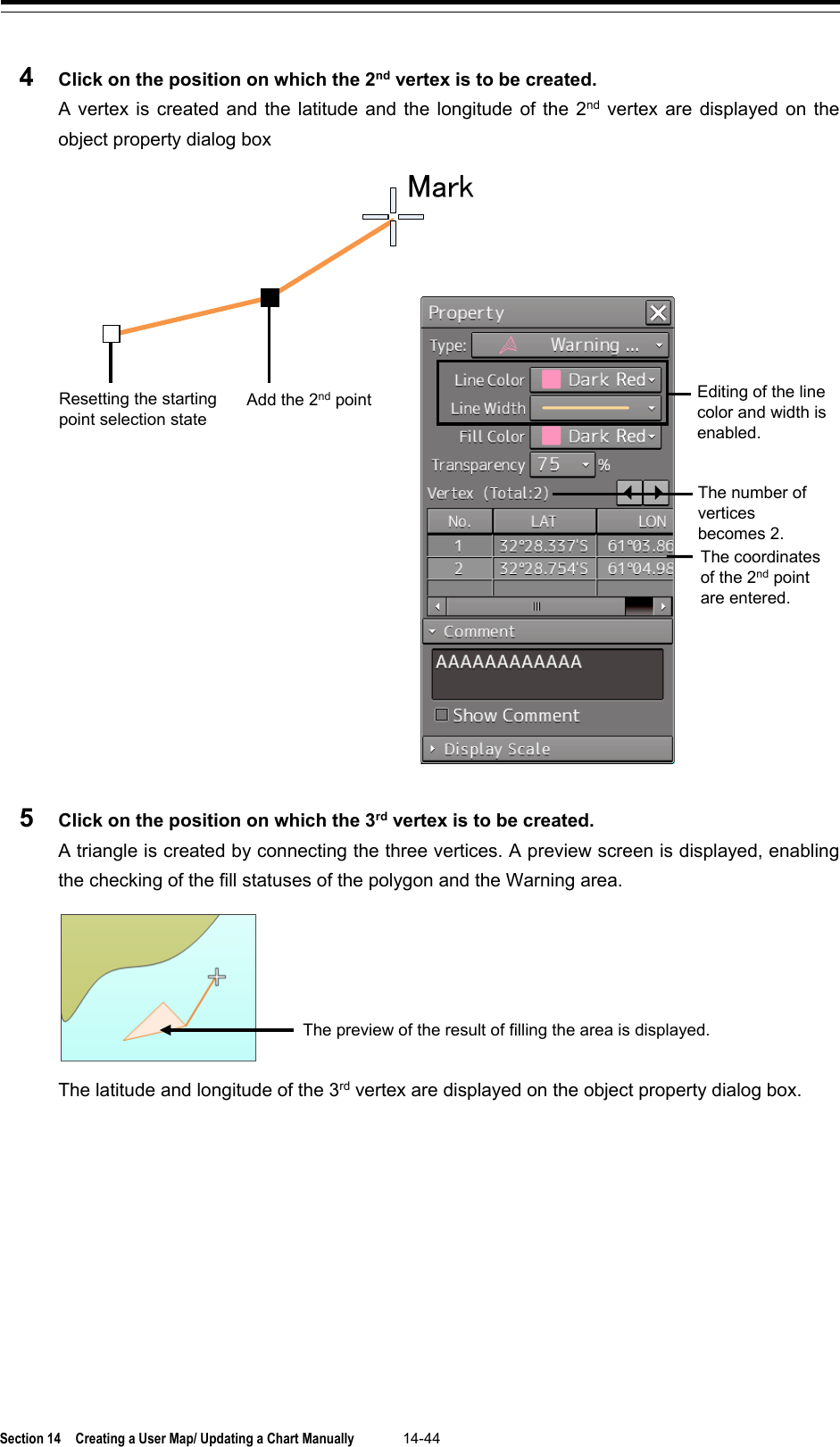
![14-45 Section 14 Creating a User Map/ Updating a Chart Manually 1 2 3 4 5 6 7 8 9 10 11 12 13 14 15 16 17 18 19 20 21 22 23 24 25 26 27 6 To add another vertex continuously, click on the position on which the vertex is to be created. When not adding any further vertices, determine the polygon or the Warning area by double-clicking the button or clicking the right button. 7 Adjust the parameters on the object property dialog box. 8 To create an object on another position continuously, repeat Steps 2 to 7. 14.5.4.1 Creating a vertex by entering the position 1 Click on the [Enter POSN] button on the drawing toolbar. The "Enter Position" dialog box appears. 2 Enter the latitude and longitude of the vertex of the object in the [Position] box and click on the [Enter] button. The position of one vertex of the object is determined. The [Bearing] box and the [Distance] box are enabled. 3 Enter the values of the latitude and the longitude of the next vertex in the [Position] box. Alternatively, enter the bearing from the vertex that was determined immediately previously in the [Bearing] box and the [Distance] input box. 4 Click on the [Enter] button. 5 Determine 3 or more vertices by repeating Steps 2 to 4. The editing of the line color, line width, fill color, and transparency is enabled. The number of vertices becomes 3. The coordinates of the 3rd vertex are entered. When the 4th vertex is determined, the preview display is updated.](https://usermanual.wiki/Japan-Radio-Co/NKE2632.Instruction-Manual-Funtion-Part-5/User-Guide-2791066-Page-101.png)
![Section 14 Creating a User Map/ Updating a Chart Manually 14-46 6 Adjust the parameters on the object property dialog box. 7 To create an object on another position continuously, repeat Steps 2 to 6. 14.5.4.2 Creating an object with EBL/VRM operation 1 Click on the [EBL/VRM] button on the drawing toolbar. The cursor changes to the EBL/VRM reference point cursor. (Refer to "14.2.5 Creating an object in the EBL/VRM mode"). 2 Click on the position of the reference point of the EBL/VRM marker. The EBL/VRM marker is displayed. 3 Place the EBL/VRM marker on the starting position and click the mouse button. A vertex is created on the position on which the button was clicked and the parameter information is reflected on the object property dialog box. (Refer to "14.2.8 Object property dialog box"). 4 Click on the position of the reference point. The EBL/VRM marker that determines the 2nd vertex is displayed. 5 Place the EBL/VRM marker on the 2nd vertex position and click the button. A vertex is created on the position on which the button was clicked and the property information is reflected in the object property dialog box. (Refer to "14.2.8 Object property dialog box"). The EBL/VRM marker is reset to the EBL/VRM reference point cursor. Starting point 2nd vertex](https://usermanual.wiki/Japan-Radio-Co/NKE2632.Instruction-Manual-Funtion-Part-5/User-Guide-2791066-Page-102.png)
![14-47 Section 14 Creating a User Map/ Updating a Chart Manually 1 2 3 4 5 6 7 8 9 10 11 12 13 14 15 16 17 18 19 20 21 22 23 24 25 26 27 6 Place the EBL/VRM marker on the position of the 3rd vertex and click the button. A triangle is created by connecting the three vertices. The preview screen is displayed, enabling the checking of the fill state of the polygon and Warning area. 7 Adjust the parameters on the object property dialog box. 8 To create an object on another position continuously, repeat Steps 1 to 7. 14.5.5 Creating circle, ellipse, and fan areas (Area object) Circle, ellipse, and fan areas can be created in the same way as for creating a circle, an ellipse, or an arc of the Line object. 1 Click on the [Type] button on the drawing toolbar. An icon list is opened. 2 Select an icon of circle, ellipse, or arc. (Refer to "14.2.3 Selecting an object type") 3 Click on the position to be the center with the cursor. A center is created and the vertex property information is displayed on the object property dialog box. Preview of the area fill result is displayed.](https://usermanual.wiki/Japan-Radio-Co/NKE2632.Instruction-Manual-Funtion-Part-5/User-Guide-2791066-Page-103.png)
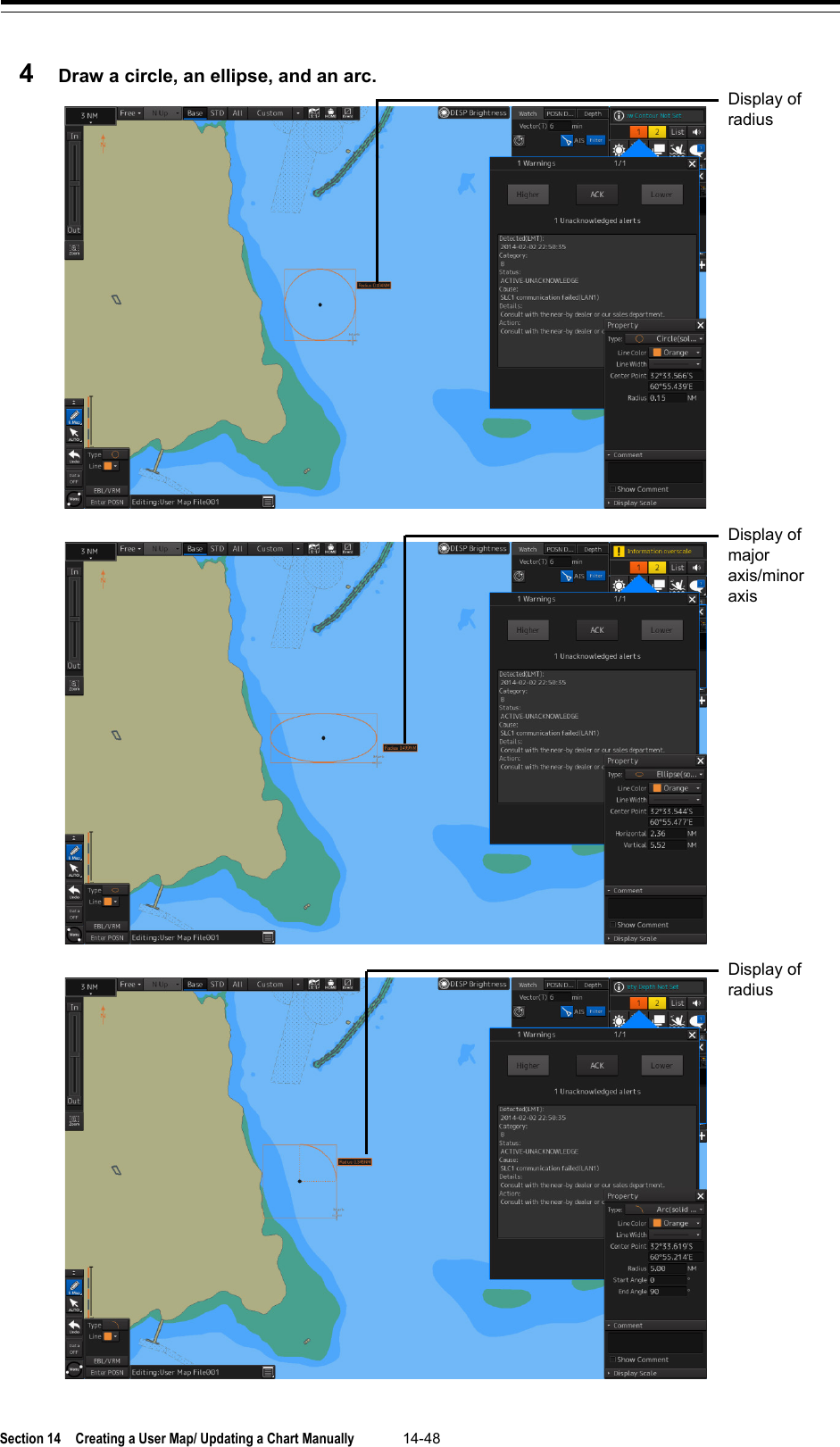
![14-49 Section 14 Creating a User Map/ Updating a Chart Manually 1 2 3 4 5 6 7 8 9 10 11 12 13 14 15 16 17 18 19 20 21 22 23 24 25 26 27 At creation of an arc, the starting angle and the ending angle of the arc to be created are the previous values or the initial values (starting angle: 0°, ending angle: 90°). To change the starting angle and the ending angle, change the values in [Start Angle] and [End Angle] on the object property dialog box. 5 Determine the object by clicking the button again. 6 Adjust the parameters on the object property dialog box. 7 To create an object on another position continuously, repeat Steps 3 to 6. 14.5.5.1 Creating an object by specifying the center position and the object size 1 Click on the [Enter POSN] button on the drawing toolbar. The "Enter Position" dialog box appears (Refer to "14.2.6 Creating an object by specifying latitude and longitude"). 2 Enter the coordinates of the center of the circle, ellipse, or arc and click on the [Enter] button on the [Enter Position] dialog box. A center point is created on the position of the specified coordinates and the property information is reflected in the object property dialog box (Refer to "14.2.8 Object property dialog box"). 3 Set the following parameters on the object property dialog box. - Circle: Enter a value of [Radius]. - Ellipse: Enter values of [Horizontal] and [Vertical]. - Arc: Enter values of [Radius], [Start Angle], and [End Angle]. 4 To create an object on another position continuously as required, repeat Steps 2 and 3. After determination, the arc is selected and the cursor moves to the center setting mode for the next arc. Click the center position](https://usermanual.wiki/Japan-Radio-Co/NKE2632.Instruction-Manual-Funtion-Part-5/User-Guide-2791066-Page-105.png)
![Section 14 Creating a User Map/ Updating a Chart Manually 14-50 14.5.6 Creating a text (Text object) Any character information can be displayed on the user map. 1 Click on the [Type] button on the drawing toolbar. An icon list is opened. Select a text (Txt) icon. (Refer to "14.2.3 Selecting an object type"). 2 With the cursor, click on the position on which an object is to be created. A text box is created at the position on which the button was clicked and a text is displayed. The parameters of the text that was created are displayed on the object property dialog box. 3 Adjust the parameters on the object property dialog box. For the text input method, refer to "14.5.6.3 Editing a text", for the template usage method, refer to "14.5.6.4 Editing a template", and for the text angling method, refer to "14.5.6.5 Changing a text angle". 4 To create an object on another position continuously, repeat Steps 2 and 3. Select a character color from the list. Select a character size from the list. Enter the coordinates of the text display position. Enter the angle from the 12 O'clock bearing when angling the text. Enter a text (up to 64 characters). To use a template, select a template from the list by clicking the button.](https://usermanual.wiki/Japan-Radio-Co/NKE2632.Instruction-Manual-Funtion-Part-5/User-Guide-2791066-Page-106.png)
![14-51 Section 14 Creating a User Map/ Updating a Chart Manually 1 2 3 4 5 6 7 8 9 10 11 12 13 14 15 16 17 18 19 20 21 22 23 24 25 26 27 14.5.6.1 Creating a text by specifying the latitude and longitude 1 Click on the [Enter POSN] button on the drawing toolbar. The "Enter Position" dialog box appears (Refer to "14.2.6 Creating an object by specifying latitude and longitude"). 2 Enter the latitude and longitude of the object to be created and click on the [Enter] button. An object is created on the specified latitude and longitude and the property information is reflected in the object property dialog box. (Refer to "14.2.8 Object property dialog box"). 3 Adjust the parameters on the object property dialog box. For the text input method, refer to "14.5.6.3 Editing a text", for the template usage method, refer to "14.5.6.4 Editing a template", and for the text angling method, refer to "14.5.6.5 Changing a text angle". 4 To create an object on another position continuously, repeat steps 2 and 3. 14.5.6.2 Creating a text with EBL/VRM operation 1 Click on the [EBL/VRM] button on the drawing toolbar. The cursor changes to the EBL/VRM reference point cursor. (Refer to "14.2.5 Creating an object in the EBL/VRM mode"). 2 Click on the position of the reference point position of the EBL/VRM marker. The EBL/VRM marker is displayed. 3 Place the EBL/VRM marker on the position on which an object is to be created and click the button. An object is created on the position on which the button was clicked and the property information is reflected in the object property dialog box. (Refer to "14.2.8 Object property dialog box"). 4 Adjust the parameters on the object property dialog box. For the text input method, refer to "14.5.6.3 Editing a text", for the template usage method, refer to "14.5.6.4 Editing a template", and for the text angling method, refer to "14.5.6.5 Changing a text angle". 5 To create an object on another position continuously, repeat Steps 2 to 4.](https://usermanual.wiki/Japan-Radio-Co/NKE2632.Instruction-Manual-Funtion-Part-5/User-Guide-2791066-Page-107.png)
![Section 14 Creating a User Map/ Updating a Chart Manually 14-52 14.5.6.3 Editing a text 1 Click on the [Text] input box A character input full keyboard is displayed. 2 Create a text. For the method of using the character input full keyboard, refer to "3.15.2 Name and function of each section of the keyboard". 3 Close the character input full keyboard by clicking on the [Enter] key. 4 To change a character color, select a required character color from the [Color] combo box. 5 To change a character size, select a required character size from the [Font size] combo box. 14.5.6.4 Editing a template By registering a frequently used text as a template, the template can be used at text creation. 1 Click on the [Edit Template] button. The "Template" dialog box appears. Text input area [Register] button Template List [Delete] button](https://usermanual.wiki/Japan-Radio-Co/NKE2632.Instruction-Manual-Funtion-Part-5/User-Guide-2791066-Page-108.png)
![14-53 Section 14 Creating a User Map/ Updating a Chart Manually 1 2 3 4 5 6 7 8 9 10 11 12 13 14 15 16 17 18 19 20 21 22 23 24 25 26 27 2 Click on a text input area. A character input full keyboard is displayed. 3 Create a text. For the method of using the character input full keyboard, refer to "3.15.2 Name and function of each section of the keyboard". 4 Close the character input full keyboard by clicking on the [Enter] key. 5 Click on the [Register] button. 6 Close the "Template" dialog and click on [] on the right side of the text input area of the object properties dialog. [Template List] is displayed. 7 Select any template. 8 To delete unnecessary templates, select unnecessary templates in the [Template List] and click on the [Delete] button.](https://usermanual.wiki/Japan-Radio-Co/NKE2632.Instruction-Manual-Funtion-Part-5/User-Guide-2791066-Page-109.png)
![Section 14 Creating a User Map/ Updating a Chart Manually 14-54 14.5.6.5 Changing a text angle Under the factory setting, a text is oriented horizontally. The text can be angled or inverted according to the text creation position. 1 Click on the [Angle] input box. A numeric value input keyboard is displayed. 2 Enter an angle. Specify an angle in clockwise based on the direction of the 12 O'clock as 0°. Under the factory setting, the angle is set to 90° (horizontal). For the method of using the numeric value input keyboard, refer to "3.15.2 Name and function of each section of the keyboard".](https://usermanual.wiki/Japan-Radio-Co/NKE2632.Instruction-Manual-Funtion-Part-5/User-Guide-2791066-Page-110.png)